











George Bolster, ‘Communication: We Are Not The Only Ones Talking...’, installation view; photograph by Tomasz Madajczak, courtesy the artist and Uillinn: West Cork Arts Centre.
6. Roundup. Exhibitions and events from the past two months.
8. News. The latest developments in the arts sector.


9. Guerrilla Painting. Cornelius Browne considers connections between underground filmmaking and plein air painting. Turning Towards a Rupture. Fiona Hallinan discusses the demolition of Ireland’s second largest catholic church.
10. Intrinsic Models of Accessibility. Iarlaith Ni Fheorais outlines a forthcoming access toolkit for curators and producers. The Fabric of Nostalgia. Belfast-based artist, Anushiya Sundaralingam, reflects on her multidisciplinary practice.
11. Unruly Forms of Care. Cecilia Graham and Grace Jackson discuss their curatorial residency at PS² in Belfast. To Huddle. Saidhbhín Gibson outlines an informal art discussion group she has been convening since 2017.
12. An Art to Grief. Day Magee reflects on the significance of losing their father and the profound art of human grief. How to create a fallstreak. Neva Elliott discusses her recent solo exhibition at Linenhall Arts Centre.
Organisation Profile
13. Greywood Arts. Jessica Bonenfant outlines the evolution of a multi-disciplinary artist’s residency and hub in Cork.
Career Development
14. Older Than Our Gods. Brian Curtin interviews artist George Bolster about the evolution of his practice.
16. Home, Architecture, Territory. Miguel Amado interviews Alice Rekab about evolving thematic concerns in their practice.
19. Fiona Kelly, No Such Thing as Away #3, 2023; photograph by Kate-Bowe O’Brien, courtesy of the artist.


20. John Beattie, ‘Reconstructing Mondrian’, Hugh Lane Gallery
21. Anthony Luvera, ‘She/ Her/ Hers/ Herself’, Belfast Exposed
22. Fiona Kelly, ‘A Demarcation of Time’, RHA Ashford Gallery
23. Raymond Watson, ‘Apis Mellifera', ArtisAnn Gallery
International
25. Leaking Lands. Miguel Amado and Georgia Perkins outline a solo show by Ofri Cnaani presented at Rampa in co-production with SIRIUS.
26. Image as Protest. Varvara Keidan Shavrova reviews an exhibition by Joy Gerrard and Paula Rego, currently showing at Cristea Roberts Gallery in London.
Exhibition Profile
28. Xenophon: Making Oddkin. Michaële Cutaya reviews Siobhan McGibbon’s recent solo exhibition at Galway Arts Centre.

Project Profile
30. The Invisible Museum. Curator Brendan Fox outlines recent and forthcoming projects from the Museum of Everyone.
31. Centre Becomes Margin. Léann Herlihy reflects on their recent performance at Project Arts Centre.
32. Systemic Crisis. Maximilian Le Cain reviews Doireann O’Malley’s new 3D theatre play, Conversations on a Crosstown Algorithm.
VAI Member Profile
34. Shetland: An Archaeology of the Unknown. Jackie Flanagan outlines a recent body of tar paintings made in Shetland.
35. Vision Over Visions. Pat Boran reflects on a recent exhibition by VAI and Aosdána member, Sean Fingleton.
36. Rural Mythologies. Shane Finan discusses some of his recent site-responsive projects.
Last Pages
37. Public Art Roundup. Art outside of the gallery
38. Opportunities. Grants, awards, open calls and commissions.

The Visual Artists' News Sheet:
Editor: Joanne Laws
Production/Design: Thomas Pool
News/Opportunities: Thomas Pool
Proofreading: Paul Dunne
Visual Artists Ireland:



CEO/Director: Noel Kelly
Office Manager: Grazyna Rzanek
Advocacy & Advice: Elke Westen
Membership & Projects: Siobhán Mooney
Services Design & Delivery: Alf Desire

News Provision: Thomas Pool
Publications: Joanne Laws
Accounts: Grazyna Rzanek
Board of Directors:
Michael Corrigan (Chair), Michael Fitzpatrick, Richard Forrest, Paul Moore, Mary-Ruth Walsh, Cliodhna Ní Anluain (Secretary), Ben Readman, Gaby Smyth, Gina O’Kelly, Maeve Jennings, Deirdre O’Mahony.
Republic of Ireland Office
Visual Artists Ireland

The Masonry
151, 156 Thomas Street
Usher’s Island, Dublin 8
T: +353 (0)1 672 9488
E: info@visualartists.ie
W: visualartists.ie
Northern Ireland Office
Visual Artists Ireland 109 Royal Avenue Belfast
BT1 1FF
T: +44 (0)28 958 70361
E: info@visualartists-ni.org
W: visualartists-ni.org
Patricia
10 Feb — 21 May
A major retrospective by one of Ireland’s most accomplished and respected artists


Admission: Free Book Now at imma.ie
 IMAGE: Patricia Hurl, The Kerry Babies Trial, 1985 / oil on canvas, 155 x 109 cm / Drogheda Municipal Art Collection, Highlanes Gallery / Courtesy The Highlanes Gallery / Photographer: Jenny Callanan
IMAGE: Patricia Hurl, The Kerry Babies Trial, 1985 / oil on canvas, 155 x 109 cm / Drogheda Municipal Art Collection, Highlanes Gallery / Courtesy The Highlanes Gallery / Photographer: Jenny Callanan
The Arts Council’s Artist in the Community (AIC) Scheme, managed by Create, offers awards to enable artists and communities to work together on researching, developing, and delivering projects.



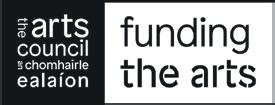
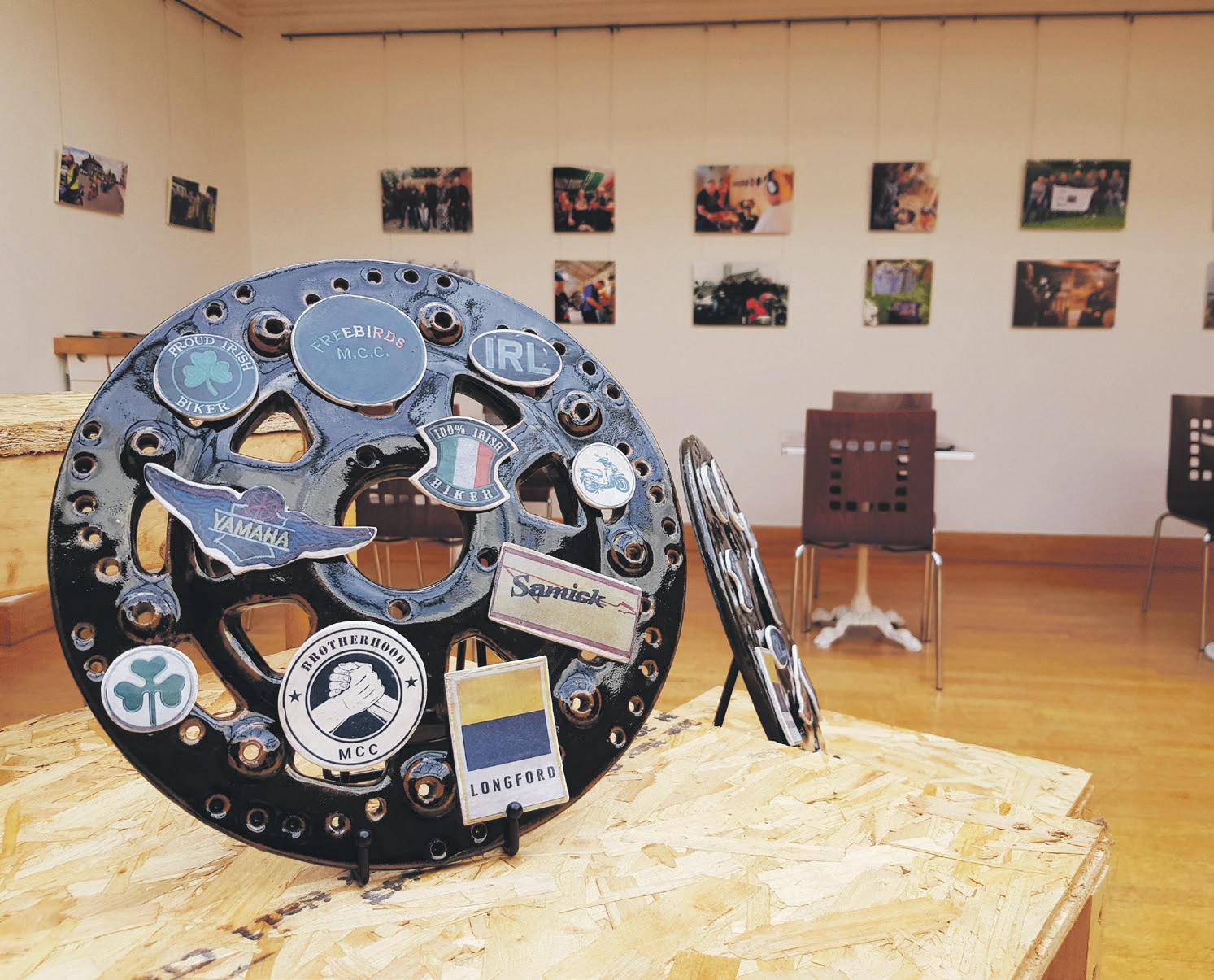
Closing Dates

Round One: 27 March, 2023
Round Two: 25 September, 2023 www.create-ireland.ie
Daniel Tuomey
Venus Patel
Tanad Aaron


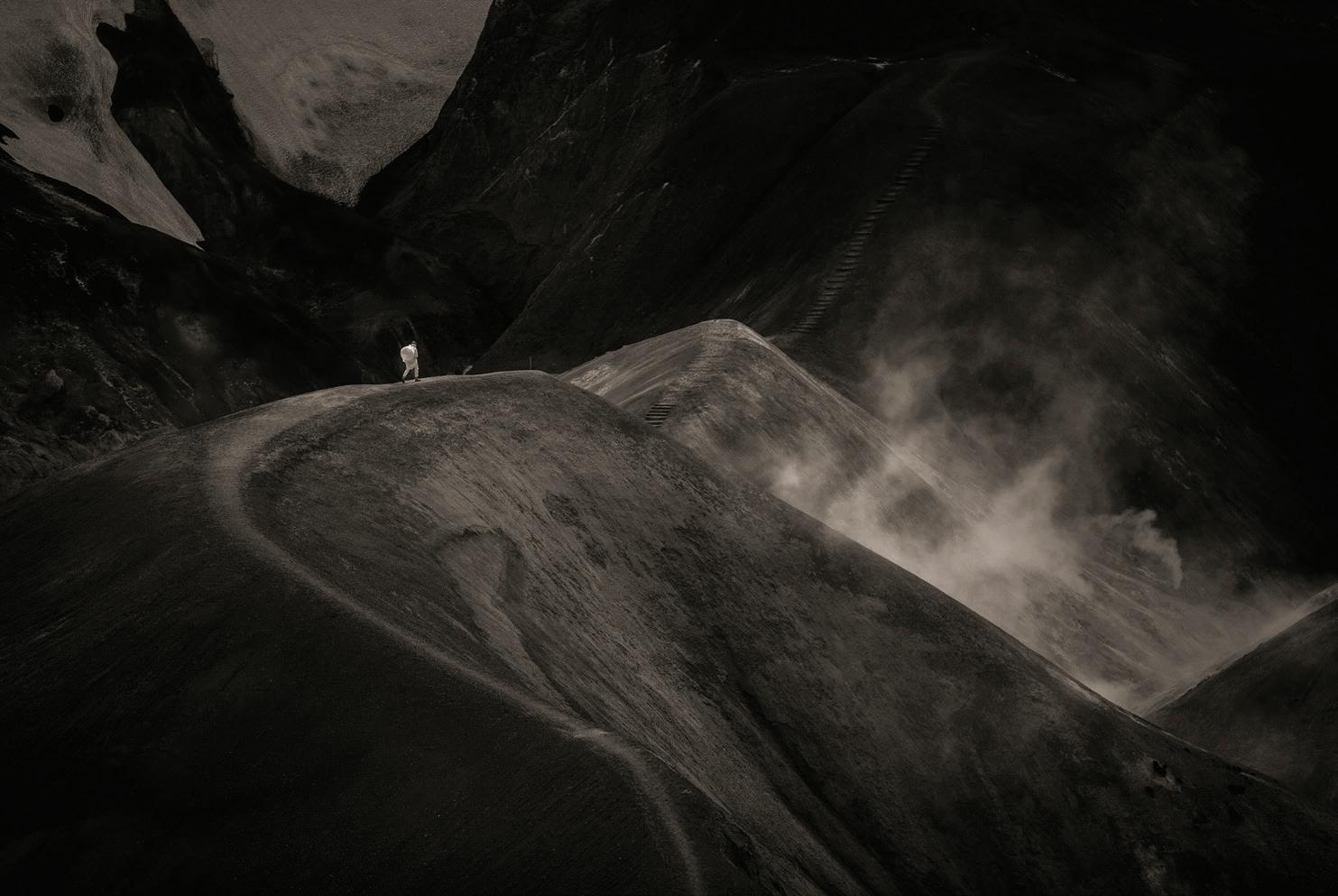



Dublin Black Church Print Studio
Black Church Print Studio presented ‘Love you my sweaty’, curated by Sara Muthi, winner of Black Church Emerging Curator Award, at The Library Project. The often discarded aspects of daily life can reveal poignant realities and important commentaries about the human condition, class structures, and lived experience. With this exhibition, Ella Bertilsson, Susan Buttner, An Gee Chan, Michelle Malone and Alison Pilkington look to restage inner dialogues ranging from the silly to the existential. On display from 13 to 28 January. blackchurchprint.ie
Hang Tough Contemporary
Hang Tough Contemporary in collaboration with Ceadogán Rugs presented the ‘Island’ exhibition in aid of the Peter McVerry Trust. ‘Island’ was an ambitious undertaking in which Ceadogán invited 12 of Ireland’s leading artists to collaborate on creating a unique one-off rug or wall hanging based on each artist’s designs. The work was exhibited at Hang Tough Contemporary from 26 January to 5 February and was then auctioned by Whyte’s Auctioneers on Sunday 5 February.
hangtoughcontemporary.com
The Irish Architectural Archive and Askeaton Contemporary Arts presented ‘Little Republics: Preparations and Elements’, a solo exhibition by Adrian Duncan. This extensive presentation of artworks and interventions is the culmination of a yearlong artist residency scheme situating the artist between Dublin and Askeaton. During this time, Duncan has researched and developed a new series of sculptures, displays and printed matter, each related to the cultural impact of the housing phenomenon ‘Bungalow Bliss’. On display from 13 January to 3 March.
iarc.ie
Draíocht
Pushing into space is the first solo show by Ellen Duffy, Draíocht’s resident artist 2022/2023, commissioned by Draíocht and curated by Sharon Murphy. Duffy works across sculptural assemblage, expanded painting, mixed media collage and drawing. Her process is playful and seeks the building of dialogue between the objects and materials used in her work. For this new body of work, Duffy has adopted and retranslated found and sourced materials during her year-long residency at Draíocht. On display from 1 March to 29 April.

draiocht.ie
IMMA
‘Xenogenesis’ brought together a selection of works by The Otolith Group, the London-based artist collective founded in 2002 by Anjalika Sagar and Kodwo Eshun. The Otolith Group’s pioneering artworks address contemporary social and planetary issues, the disruptions of neo/colonialism, the way in which humans have impacted the earth, and the influence of new technology on consciousness as well as “a science fiction of the present” through images, voices, sonic images, sounds, and performance.
imma.ie
‘Time Sensitive: Leeward’ presented a series of reflections and observations rooted in the artists’ lived experiences. Artists Anne Vetter, Frank Abruzzese, Karl Logge & Marta Romani, Laurence O’Toole, Rosie O’Gorman, Sarah Ellen Lundy and curator Karla Sánchez, have all resided for long periods in both city and countryside, the latter being the place where, in the last several years, they have spent most of their time. The Rural is not a unified and defined space; it is hybrid, it is complex. There are, also, multiple discourses of rurality. On display from 28 January to 10 February. mart.ie
Bbeyond
Bbeyond celebrated the 80th birthday of one of their founding members, trustee and current committee member Alastair MacLennan on 3 February. MacLennan has been an inspirational, seminal figure in the Northern Irish, Irish and UK performance art world. He continues in his 80th year as a vibrant practicing artist whose openness draws many not only to his work but to him as a person, his practice and life intertwined. ‘Art in life, life in art’, the Bbeyond motto, is certainly true of MacLennan.
bbeyond.live
Naughton Gallery
Featuring a range of local and international artists, ‘NGXX’ spanned a broad variety of processes and practices. Painting, photography, drawing, sculpture, illustration, tattoos, and textiles are all represented. The 20th anniversary of the Naughton Gallery is commemorated through a visionary, panoramic survey of a truly exciting roster of artists at various points in their careers, from established names to emerging talents. On display from 13 October 2022 to 29 January 2023.
naughtongallery.org
QSS
QSS presented the 2022 graduates from Belfast School of Art as part of ‘Emergence VI’. Now in its sixth year, the annual ‘Emergence’ exhibition provides a professional platform for recent graduates at a transitional stage in their career. The exhibition featured work by: Adam Skinner, Brea Freeburn, Darcy Patterson, Deborah Adair, Emma Stewart, Eva Perrott, Katie Ballentine, Louise Kennedy, Luke Foster, Melissa McKee, Miles Smith, Natalie Gibson, Reuben Brown, Rhys Murphy and Tomas Antunes. On display from 12 to 9 February.
queenstreetstudios.net
Golden Thread Gallery
Golden Thread Gallery presented Phillip McCrilly’s first solo show in the project space of the gallery titled ‘I Can Never Nail the Days Down’. Curated by Mary Stevens, the exhibition explores “gender socialisation, considered ideas around home, as well as the potential for a fulfilled queer life in a rural Irish context.” The work questions McCrilly’s own relationship with the post-conflict period, intimacy and research into the connection of people and place. On display from 7 January to 18 February.
goldenthreadgallery.co.uk
Pollen Studio and Gallery
Aoibhin Maguire is an artist from Belfast, who now lives and works in London. ‘This Earth is Alien to me’ was Aoibhin’s first solo exhibition. Interested in emotion, place, home, storytelling, diaries, chaos and daydreaming, Aoibhin contrasts her complex subject matter with her use of bright colour – something which she has always been drawn to. The title alludes to her experiences of imposter syndrome throughout her time on earth. On display from 2 to 4 February.
pollenstudiobelfast.com
Ulster Museum
‘The Druithaib’s Ball’ is the 2021 Turner Prize-winning installation by the Belfast-based artists known as Array Collective. They are the first artists from Northern Ireland to win the prestigious Turner Prize. The group of eleven artists from the north and south of Ireland, England and Italy all live and work in Belfast creating collaborative actions in response to socio-political issues affecting them and their communities. The exhibition continues until 3 September.
ulstermuseum.org

Backwater Artists Group presented ‘Tonnadh // Fuaim an Toinne’, an exhibition of work by Bríanna Ní Léanacháin, which ran from 26 January to 17 February. Bríanna is the recipient of the Backwater Artists Group Ciarán Langford Memorial Bursary 2021. The exhibition consisted of a video-based installation, exploring the changing relationship to the landscape and inspired by research into folklore and ancient Irish history. It addressed the overwhelming anxiety born from the current climate crisis through Irish folklore. backwaterartists.ie
‘Catherine McWilliams: Selected Work 1961 – 2021’ runs until 3 June. For over six decades, McWilliams has produced original and compelling images of life in Northern Ireland. From a self-portrait painted when she was 21 to recent compositions exploring the threat of climate change, her work ranges from the domestic to the surreal and prioritises the experiences of women and children. McWilliams lives in North Belfast, in the shadow of Cavehill, and taught in a local secondary school during the worst years of the conflict.
femcwilliam.com
‘At The Gates of Silent Memory’, is a solo exhibition of photography by Clare Langan, curated by Eamonn Maxwell. Known for her expansive and award-winning film projects, which have been seen in galleries and festivals across the world, Langan has a parallel photography practice using digital SLR and the unique Hasselblad XPan cameras. These images are taken in locations around the world including Dubai, Iceland, Kerry, and Monserrat reflecting Langan’s practice and environmental concerns. Exhibition continues until 20 April.
athlone.ie
The PhD exhibition ‘Re-Cover’ ran from 19 January to 24 February. There was also a symposium on 25 January at the BCA Lecture Hall and online via Zoom. ‘Re-Cover’ included the work of nine current PhD students – Fadwa Bouziane, Qi Chen, Kat Cope, Kate Collyer, Katerina Gribkoff, Joseph Hendel, Kelly Klaasmeyer, Robbie Lawrence, and Ling Liu – who collectively covered ground through artistic research. The artists are searching and re-searching for new understandings: both un-covering and re-covering systems.
burrencollege.ie
glór
Due to the ongoing war, contemporary artist Yevhen Svitlychnyi was forced to flee Ukraine for Ballyvaughan and the Burren. In Ukrainian, painting is called obrazotvorche mystetstvo, literally the art of creating images. In the works presented in this exhibition, the images of the unspeakable tragedy of the war are created through the prism of thousands of years of biblical history, and culture: war – death – life – image – myth. ‘The Burren – Ukrainian Chronicles: Part III’ was on display from 27 January to 25 February.

glor.ie
‘Lined Out’ is an exhibition by Emma Roche, recipient of the 2021 Wexford Arts Centre EMERGENCE Award. With an idiosyncratic approach to painting encompassing weaving, knotting and knitting, Roche’s unorthodox textural paintings are accompanied by a new large-scale commission of hand-screen printed works on paper by ‘Small Night’ by James Merrigan. Roche’s preparatory drawings, made quickly and obsessively, are informed by the humdrum of repetitive daily tasks. Exhibition continues until 11 March.
mermaidartscentre.ie
Niamh McCann’s ‘Hairline Crack [a dialogue]’ is a new multimedia body of work that responds to the 100th anniversary of a North-South border. Metaphorically mining the deep seams of colonialist atrocities and plundering, it combines sculpture, collage and video to question the vestiges of dominant power structures. McCann cuts through well-devised spectacles to subvert landscapes, material histories as well as the dominion humans have held over earth. On display from 3 February to 26 March.
centreculturelirlandais.com
GOMA
‘I brought the dream of flying…’ was a new exhibition by artists Corina Duyn and Caroline Schofield, that took place at GOMA Gallery of Modern Art, Waterford, from 14 January to 11 February. Inspired by a broken-winged bird puppet which accompanied Corina when she moved to a full-time nursing home care last year, the exhibition features work made in response to this move and illustrates the new collaborative creative process Corina has developed with Caroline as a result of her increasing disability.
gomawaterford.ie
There is nothing like a period of enforced isolation to remind us of the deeply human (and non-human) need to come together. ‘If We Could See Ourselves As Others See Us’ by Brian Irvine and John McIlduff (Dumbworld), is a sound, video and living installation inspired by a journey through moments of assembly across Meath. Choirs now able to join and sing together, swimmers taking the cold plunge together, gravestones repurposed as picnic tables for gatherings, trees connecting under the earth in a network of support. On display from 14 to 27 January.
solsticeartscentre.ie
‘Inverts on the castle wall, Perverts in the tall grass below’ by Kian Benson Bails, presented a body of work produced through investigations into rural Ireland, aesthetic language associated with rural and regional art spaces and queer communities. Using historical canon to construct alternative narratives around Irish queerness, the title of the exhibition frames language, and anglicisation of queer academia and asks how this written and documented theory is engaged in Irish culture. On display from 1 December 2022 to 15 January 2023. customhousestudios.ie
Lavit Gallery presented Helen Cantwell and Bernie Hennessy, with the 2022 Roberts Nathan Student of the Year Award. This is an annual award given to one or more graduates of MTU Crawford College of Art & Design. In addition to an exhibition at Lavit Gallery, both artists receive a cash prize of €500 sponsored by Roberts Nathan Accountants, Cork. This exhibition marks the beginning of Lavit Gallery’s 60th anniversary programme. On display from 26 January to 18 February.
lavitgallery.com
The Model presents Niamh O’Malley’s ‘Gather’ – the critically acclaimed exhibition that represented Ireland at the 2022 Venice Biennale. Works from Ireland at Venice are brought into an expanded dialogue with a larger selection of O’Malley’s artwork. This exhibition also reveals and considers the influence of the west of Ireland on her work.
Born in County Mayo, O’Malley uses many materials including steel, limestone, wood, and glass. She shapes and assembles objects to create a purposeful landscape of forms. On display from 3 February to 9 April. themodel.ie

Uillinn: West Cork Arts Centre and the Crespo Foundation are very pleased to announce visual artist Dominic Thorpe as the recipient of the inaugural Uillinn: West Cork Arts Centre Residency Award 2023 supported by the Crespo Foundation. The Frankfurt-based foundation, originally established by the photographer, psychologist and philanthropist Ulrike Crespo (1950-2019), carries out operational projects in the fields of art, education and social affairs.
The Uillinn/Crespo Residency is a residency opportunity open to contemporary visual artists based outside the county of Cork and encompasses a purpose-built studio at Uillinn, accommodation in Skibbereen, travel costs and a weekly stipend of €350 over an eight-week
PhotoIreland announced the five Irish artists selected to join the FUTURES Photography Platform in 2023. They are: Aindreas Scholz, Emilia Rigaud, Niamh Barry, Phelim Hoey, and Ryan Allen. In joining the platform, now in its sixth year, they not only enter a growing list of talent from across Europe, but also benefit from a growing range of opportunities supported by Creative Europe and the 18 platform members planned throughout the present year, culminating in an annual networking event at the Robert Capa Contemporary Photography Centre in Budapest.
PhotoIreland continues its role as the Irish member of the platform, supporting contemporary artists and bringing international practices to Ireland. Currently, PhotoIreland is working closely with FOMU, Fotodok, and Robert Capa Contemporary Photography Centre co-curating the annual travelling FUTURES exhibition and co-editing the annual publication. The exhibition will travel to Fotodok and then to Dublin in July 2024, in the context of the FUTURES Meet Up event, and will be accompanied by a busy networking and educational programme for audiences and artists in addition to the exhibition.
Former tenants of Belfast’s Cathedral Buildings, which was devastated by fire last year, are set to benefit from £154,696 of funding support to sustain their work.
The Arts Council of Northern Ireland announced that 13 former tenants of Cathedral Buildings are set to receive £154,696 of exchequer funding, supported by the Department for Communities (DfC) and Belfast City Council, as part of the Cathedral Buildings Fire Support Programme.
On Monday 3 October 2022, the Old Cathedral Buildings on Donegall Street, Belfast, was devastated by fire severely impacting the livelihoods of the many creative businesses, sole traders and practicing artists based there.
Following an initial exercise to gauge the former tenants’ needs, the Arts Council of Northern Ireland, in partnership with the Department for Communities and Bel-

period from 22 July to 16 September 2023. The open call for the residency received 167 applications from all over the world. The selection panel noted the exceptionally high standard of proposals received.
Dominic Thorpe works in performance art, as well as drawing, video, photography, installation and relational processes. Dominic’s work has addressed a range of critical content, most recently focusing on collective memory and perpetrator trauma. He has regularly engaged with artist-run initiatives as well as inclusion and education-based projects and organisations.
fast City Council, launched the Cathedral Buildings Fire Support Programme in December 2022. The programme offers former tenants funding to counter the costs incurred as they relocate and seek to re-establish themselves.
Dr Suzanne Lyle, Head of Visual Arts, Arts Council of Northern Ireland, added, “The Arts Council of Northern Ireland welcomes this good news and is grateful to the Department for Communities for making this vital funding available to those whose livelihoods were devastated by the Cathedral Buildings fire. This funding is absolutely critical in helping these artists and arts organisations reactivate their work, sustain their artistic practice and manage existing projects.”
John Ball, Head of DfC’s Arts Branch said: “The Department’s support to those impacted by the fire in the Cathedral Buildings is a signal of the importance placed on the people and organisations who work to make our arts sector what it is. We were pleased to be able to work together with the Arts Council, Belfast City Council and Libraries NI to provide this practical and much needed help.”
Councillor Ryan Murphy, Chair of Belfast City Council’s City Growth and Regeneration Committee said: “The impact of the fire has been devastating for the former tenants of Cathedral Buildings. As well as providing funding, we’ve worked in partnership with the Destination CQ BID, to support tenants to relocate, to navigate their insurance policies where possible, and to offer business support services. I’m glad that we’ve been able to collaborate with the Department for Communities and the Arts Council of Northern Ireland to give these businesses and cultural organisations vital support and I wish them all every success in their new locations.”
Another recipient of the Cathedral Buildings Fire Support Programme is Digital Arts Studios (DAS), a non-profit organisation that provides artists’ residencies, equipment hire, training, outreach and exhibitions. DAS is a space for artists and creatives to work, learn and advance their careers and the organisation aims to support and encourage visual artists whose innovative work merges with digital technolo-
gies. DAS will use their funding to replace equipment that will be used by visual artists on the DAS residency programme and by participants in their in-studio workshops, training and support hub services.
Dr Angela Halliday, Director, Digital Arts Studios, commented, “Digital Arts Studios is delighted to have received funding from the Cathedral Buildings Fire Support Programme. This funding will help purchase essential equipment for artists to use to develop skills and create new work. Digital Arts Studios is grateful to the Department for Communities, Arts Council of Northern Ireland and Belfast City Council for this much-needed assistance, and we look forward to welcoming artists to our new premises at 1 Exchange Place, Belfast, where they can make use of the new equipment and resources.”
All those set to receive funding through the programme include:
• Aidan Mulholland T/a Mulholland Violins (£45,280)
• Dermot Gibson (£600)
• Digital Arts Studios (£21,100)
• Ellen Blair (£829)
• Elly Makem (£607)
• Excalibur Press Ltd (£21,851)
• Form Native Limited (£11,461)
• Hazel Alderdice T/A Perfect Fit (£5,045)
• Jennifer Mehigan (£11,405)
• Nicholas J Larkin T/A Roscio Films (£4,207)
• Oranga Creative Ltd (£12,804)
• Suzanne Magee (£1,573)
• Timothy Farrell (£17,934)
Pallas Projects/Studios and its Board of Trustees are delighted to announce that the organisation has been granted Charitable Status by the Charities Regulator. This hugely significant development, a key objective of their long-term strategic planning, is the culmination of several years of dedicated work. It helps ensure that the organisation is best placed to continue their role as a leading exponent of artist-run practices on the island of Ireland, and to provide and develop opportunity for Irish artists to make and exhibit cutting-edge and experimental work.
In addition, and in line with recent organisational and programmatic developments and in tandem with their Charitable Status, they wish to announce a restructuring of roles at Pallas Projects/Studios. They are delighted that their long-standing assistant curator Eve Woods is to take on the role of Curator/Programme Producer, with Mark Cullen and Gavin Murphy acting as joint Artistic Directors.
Pallas Projects/Studios and its Board of Trustees would like to thank all those involved in the organisation, their staff, studio artists, exhibiting artists and those who visit, engage with their exhibition and education programmes. In particular they wish to thank The Arts Council for their continued support.
Pallas Projects/Studios look forward to continuing their role in advocating for increased supports for artists workspaces in 2023 and beyond, and in delivering artistic and educational programmes to ensure the best emerging and early career artists can have every opportunity to thrive and produce new, exciting and meaningful work, now and into the future.
Eight artists awarded studios at TBG+S Temple Bar Gallery + Studios is pleased to announce the awarded artists from the open call for Three Year Membership Studios and Project Studios.
Three Year Membership Studios have been awarded to Clodagh Emoe, Lisa Freeman, Jaki Irvine, and Jesse Jones. Project Studios have been awarded to Tara Carroll, Maïa Nunes, Mandy O’Neill, and Luke van Gelderen.
Three Year Membership Studios at Temple Bar Gallery + Studios offer a long-term tenure to artists who have developed an established, professional practice. Project Studios offer a one-year tenure to artists who are developing exciting emerging practices and demonstrate talent and potential.
The artists were awarded their studios by a selection panel following an open submission application process. The panel included current TBG+S Studio members and established curators based in Ireland and internationally. The artists are representative of the high-quality and rigorous contemporary art practices in Ireland today.
CORNELIUS BROWNE CONSIDERS CONNECTIONS BETWEEN UNDERGROUND FILMMAKING AND PLEIN AIR PAINTING.
FIONA HALLINAN DISCUSSES THE DEMOLITION OF IRELAND’S SECOND LARGEST CATHOLIC CHURCH.

“To demolish is to obliterate, to eradicate, to erase, to destroy. Informally, the verb is used to describe an overwhelming defeat. It is the end.” – Ellen
Rowley, Making Dust (2023)IT COULD BE a catharsis to watch a building come down. Indeed, many demolitions have been presented as spectacle; as opportunities for gathering and celebrations in themselves. Watching a church come down could represent a purge – a way of starting over from a failed plan. ‘Emotional residue’ is a term in social psychology that describes how buildings and objects contain real, tangible traces of events in the lives of their inhabitants that can be sensed by other people over time.1
at VISUAL Carlow until 14 May. It will also be presented at the Irish Architectural Archive later this year (14 September – 20 October). The project includes a film, Making Dust (2023), that maps the research and writing of architectural historian Ellen Rowley on to the process of dismantling the church, and a table made from fragments of the demolition. At a symposium in May, the table will be activated with a meal, gathering different perspectives on the project. Rowley notes that a swathe of buildings, including the large-scale churches of Catholic Ireland, will be threatened with demolition. Built within the last 50 years or so, they don’t seem old enough to be considered of historic virtue.
TWENTY YEARS AGO this spring, I was part of a skeleton crew in Leitrim, shooting Ireland’s first indigenous horror movie. Dead Meat (2004) was also the first film completed under the Irish Film Board’s Micro-budget initiative, which provided funds for projects budgeted at €100,000. In the credits, my name appears under Production Designer. However, we had so few hands and so little money, that roles were, by necessity, fluid. Over that Easter weekend, we shot some of our most exhilarating scenes in a cottage belonging to novelist John McGahern. I was introduced to McGahern on Good Friday, wearing a weighty crucifix around my neck, brandishing a fake axe, and doused in fake blood. To stretch our budget, we frequently filmed en plein air. I cherish memories of freewheeling days and nights scouting locations.
Our next film planned as a company was Chiaroscuro, a psychological horror I had written about disintegrating relationships within an artists’ colony, which I was also slated to direct. To attract funding, I created an elaborate storyboard, comprising hundreds of drawings. This was the first artwork I had produced since graduating from NCAD twelve years earlier. Despite positive feedback, Chiaroscuro languished in development purgatory, but it reignited my passion for drawing.
My original intention had been to make Chiaroscuro as a Dogme 95 film. Lars von Trier’s avant-garde manifesto proposed a new way of producing films with extremely low budgets, adhering to strict rules that he provocatively termed the ‘vow of chastity’. Dogme films had to be shot on location, using hand-held cameras without any special lighting, with direct sound recording, and no music, optical work, or filters. The manifesto attacked illusory cinema and promoted a naturalistic alternative.
During my early childhood we had no television set, and I was 19 before setting foot in a cinema. In between, we had a black and white telly, our aerial erratically
picking up signal, meaning the picture was often snowy. Graveyard slot screenings of old or disreputable films turned me into a teenage insomniac. My inclination was towards guerrilla filmmaking, the ultralow budget underground work of directors operating on the margins. One night in deepest winter, I caught the only film written and directed by Barbara Loden. Wanda (1970) was shot by a crew of four people for $100,000 on grainy 16 mm film, usually reserved for documentary work. That freezing night, I experienced a snowfall of feelings about working-class art. I recollect Loden’s ideas on mainstream filmmaking: “I hate slick pictures, they’re too perfect to be believable. I don’t mean just the look. I mean in the rhythm, in the cutting, the music – everything. The slicker the technique is, the slicker the content becomes, until everything turns to Formica, including the people.”
Ten years ago, I returned to painting. Not one of my pictures has been slick. As a painter, I have taken a ‘vow of chastity’: all paintings are created entirely outdoors in a single session, with no preliminary drawing, underpainting or photographic reference, no retouching in the studio afterwards, and no varnishing. I have vowed to paint in the open across every season, at all times of day and night, continuing to work through whatever the weather throws my way, which is unpredictable on the Donegal coast. Painting a picture like Looking at Snowy Mountains, my fingers numb with cold, I have no idea that two strangers in a boat are about to drift into view. When I call out to them to please stay where they are for a few minutes, and look towards the snow, I recall that a long time ago, I had hoped to direct a film.
Cornelius Browne is a Donegal-based artist. His current solo exhibition, ‘All Nature Has A Feeling’, continues at the RCC, Letterkenny, until 25 March.

regionalculturalcentre.com
There is an ongoing international movement to ‘de-monumentalise’ due to the reckoning with colonialism and imperialism, documented by Nicholas Mirzoeff in ‘All Monuments Must Fall’.2 Buildings, however, are not monuments. They are functional spaces that provide shelter, but which extract large amounts of natural resources in their construction. To knock a building down and build a new one is often an economic decision; but in a climate crisis, can we afford to make decisions based on the arbitrary index of financial cost? Perhaps we should pay attention to the traces left in buildings, in materials.
Finglas West’s Church of the Annunciation, by architect David Keane, was a landmark building in the area – the tallest thing around except for the mountains. Designed to hold gatherings of over 3000 people, it opened in 1967 as part of a series of giant churches built around Ireland for a decidedly Catholic society. The 1961 Census records 94.9% of the country’s population identified as Catholic; however, as this percentage continues to decrease, there are fewer reasons to justify exclusive use of a building on this scale.
‘We Turn Towards an Ending and Pay Attention’ is a project currently showing
Over the blue hoardings that concealed the demolition site, we asked passers-by what they thought about this building coming down. There was no major dissatisfaction about its dismantling; I noticed instead a distinct ambivalence. This project was not an act of protest or memorialising, but a way to mark a moment we describe as a ‘rupture’. It considers issues of land ownership, the agency of materials, sustainability, the built environment, and the legacy of the Catholic church’s power in Ireland; it asks what do we value, where do we gather, what should we keep and, in the context of a climate crisis, what should we discard?
Fiona Hallinan is an artist and researcher based between Brussels and Cork, and co-founder with Kate Strain of The Department of Ultimology. departmentofultimology.com
1 Krishna Savani et al., ‘Beliefs About Emotional Residue: The Idea That Emotions Leave a Trace in the Physical Environment’, Journal of Personality and Social Psychology, Vol. 101, No. 4, 2011, pp. 684-701 (krishnasavani.com) 2 allmonumentsmustfall.com
IARLAITH NI FHEORAIS OUTLINES A FORTHCOMING ACCESS TOOLKIT FOR CURATORS AND PRODUCERS.
MANY ARTS ORGANISATIONS and curators are eager to create more accessible spaces for art workers, audiences and artists, but struggle to find the right advice. Numerous artists have self-organised in response to inaccessible environments, creating toolkits and resources to help fellow artists advocate for themselves. Recent examples include: Access Docs for Artists, an online resource to “help disabled artists communicate their access needs with galleries, art organisations and other employers”, developed by Leah Clements, Alice Hattrick, and Lizzy Rose in 2019 (accessdocsforartists.com); and Accessibility in the Arts: A Promise and a Practice, an accessibility guide commissioned by Recess, New York, and written by Carolyn Lazard in 2019, which is “geared toward small-scale arts non-profits and the potentially expansive publics these organisations serve” (promiseandpractice.art).This has resulted in a long-awaited increase in artists sharing their access needs. Unfortunately, many curators and art organisations are still unprepared for supporting these requests.
With this in mind, I applied for Arts Council England funding to produce an access toolkit for curators and producers in late 2021. The aim of the toolkit is to provide key information on how to work, make and display accessibly in the visual arts, from fundraising and budget planning to working with artists. As a disabled curator myself, I also wanted to create a resource for disabled art workers to use to advocate for their own access needs.
I began by interviewing four disabled and/or chronically ill artists, alongside four curators and producers who either work in disabled-led art organisations, have disabilities themselves, or produce particularly accessible programmes. The artists have diverse practices with varying access needs, and all predominantly work in the UK and Ireland. For interviewees to speak openly about their experiences, their contributions have been anonymised. I asked artists about their experiences of working with institutions, curators and producers, what their access needs are, how they’ve been met in the past, and crucially, what their practice would look like if all their access needs were met. Curators and producers were asked questions on planning, policy, funding, current access provision, management, and their own access needs.
Firstly, all of the curators and producers I spoke with called for an intrinsic model of accessibility – one which centres access from the very first planning conversations, thus taking account of access needs of art workers, artists and audiences at every stage. This is opposed to the most common model, which often considers access an add-on at the end of a project. Key to making the intrinsic model work is gathering the access needs of the team, having
those early conversations with artists and colleagues, and building that into a plan. This could include people needing flexible working patterns, support workers, assistive devices or technologies, easy-to-read documents, flagging flare-ups, caring obligations, upcoming surgeries, or more time to complete tasks. A valuable way of collecting this information is an access rider – a simple document allowing artists or freelancers to share their relevant access needs, which could be requested as part of a contract.
Once access needs are assessed, their provision can be included when fundraising. It is recommended that 10% to 20% of a project budget should be ringfenced for access, therefore ensuring that if access costs arise, there is a budget in place. Many awards allow access costs to be requested above the award amount, where needed. It can be more difficult to account for access in regular organisational funding but this percentage guide is a useful metric when building access into an organisation longterm. Many artist respondents highlighted the need for access budgets to support their own access needs in the production period, and not just the display of their work. Artists also state that flexible approaches to production schedules, project outcomes, and ways of communicating are vital.
In terms of display, most interviewees advocated for a creative and intersectional approach to access. There are many ways to make an artwork accessible, but those tools should be considered alongside creative ones, as part of a holistic approach. You can’t be accessible to everyone all of the time, and there is no such thing as ‘fully accessible’. Access is a conversation and a process that will look different in every project. An intersectional approach can make working and witnessing art accessible for everyone. This may include: flexible working supports for parents or trans people undergoing care; quiet spaces for older people or those who are breastfeeding; paying people to attend meetings; or sliding-scale ticket prices for disabled people, students, pensioners, unemployed people, and those on low incomes. And everyone appreciates comfortable seating, no matter who they are.
As we consider the impact of the Arts Council of Ireland’s Equality, Diversity and Inclusion (EDI) Toolkit, it is essential that organisations provide the supports necessary to include disabled art workers, artists and audiences, beyond our own commitment to disability justice. Later this year, I will publish a free online toolkit, intended as a practical guide, outlining ways we can create more accessible practices, organisations, and ways of working across the sector.
BELFAST-BASED ARTIST, ANUSHIYA SUNDARALINGAM, REFLECTS ON HER MULTIDISCIPLINARY PRACTICE.

MY FIRST MEMORY of making art is sitting outside my classroom in the warm, open air, drawing banana and coconut trees. Growing up in Sri Lanka, I watched the making of many traditional, handmade creations for everyday cultural and religious life including crafts, textiles, and weaving. I saw patterns, colours and textures used everywhere, in all aspects of life, from births and weddings to funerals. Patterns were even made while sweeping the sandy floor of our house.
Since graduating with a degree in Fine and Applied Arts from Ulster University, I have been working as a full-time artist and arts facilitator in Belfast. While I initially trained as a printmaker, my practice has since become more diverse, working in both two and three dimensions, creating installations, paintings, prints, and mixed-media works. As a multidisciplinary artist and collector, I like to incorporate different materials and textures in my work, and frequently use less traditional materials such as thread, encaustic, flax, metal, and bamboo. Experimentation and exploration of ideas, subjects, materials and effects drive my practice and continually challenge and motivate me.
My current work reflects on challenges of identity and the nature of belonging. I am concerned with how our relationship with natural and cultural environments shape our sense of self and place, particularly if one’s surroundings change through displacement, whether by choice or not. When I left Sri Lanka in 1989, I left behind my roots, culture, identity and tradition. Over the years, my work has evolved, and I have been influenced through many different aspects of living in Northern Ireland; however, the sights and sounds of my childhood regularly influence and inspire my work, enabling me to reconnect with some of the things I have lost.
My next solo exhibition runs from 9
March to 6 April at Island Arts Centre, Lisburn, and is entitled ‘Rip it Up and Start Again’. It is kindly supported by a grant from Lisburn & Castlereagh City Council. This exhibition takes the sari, a traditional item of Sri Lankan clothing, and reworks metres of cloth to tell a new story of the generations of women who wore this fabric. Collected saris from the Sri Lankan diaspora, many passed down in families, have been ripped and reworked to create new works. Fabrics that come from everyday settings to special occasion wear have been imbued with meaning, perhaps sadness, joy, sentimentality and nostalgia. This exhibition speaks of Sri Lankan communities throughout the world yet reflects on a very basic human sense of identity, and what that means.
Depending on my practice, I can work from my home studio, at Belfast Print Workshop, or at Queen Street Studios, where I am a member. Sharing creative practice is important to me, and I have facilitated many short and long-term projects for all ages and abilities. I enjoy giving something back. I come from a society where art is not valued as a profession, and although my family has always been supportive, I have had to fight to be respected as an artist. I have recently been awarded the 2022 Artist’s Career Enhancement Scheme from the Arts Council of Northern Ireland for a project with the Ulster Museum, titled ‘தப்பிஓடு TappiOdu (Flee)’.
Anushiya Sundaralingam is a multidisciplinary artist based in Belfast. anushiyaartist.co.uk
The Angelica Network amplifies the voices of women and non-binary artists of minority cultural and ethnic backgrounds. angelica.network/home
CECELIA GRAHAM AND GRACE JACKSON DISCUSS THEIR CURATORIAL RESIDENCY AT PS² IN BELFAST.

SAIDHBHÍN GIBSON OUTLINES AN INFORMAL ART DISCUSSION GROUP SHE HAS BEEN CONVENING SINCE 2017.
I WAS LIVING between Carlow and Kilkenny around 2014. At the time, I felt there was limited opportunity in the immediate area to engage in discourse around contemporary art. I wanted to develop an event which had the potential to bring people together to have critical conversations and to share knowledge. I also wanted to create an inclusive event for a community to interact, socialise and be visible to one another. I imagined a group of us, huddled over hot cups of tea. I think the fact that I was renting a very cold apartment influenced this Dickensian image.
“Terms like serious and rigorous tend to be code words [...] for disciplinary correctness; they signal a form of training and learning that confirms what is already known according to approved methods of knowing, but they do not allow for visionary insights or flights of fancy.”
– Jack Halberstam, The Queer Art of Failure (Duke University Press, 2011)
WHEN WE STARTED collaborating, we were approaching the end of our curatorial master’s programme, both exhausted, disappointed, and heartbroken. We had hoped for a discursive programme that encouraged conversations about dismantling patriarchal and hierarchical structures within the institution. Instead, we felt that the university perpetuated those institutional structures, requiring a rigid professionalism that treats artists as tools to uphold curatorial discourse and power.
Care was, and still is, at the centre of discussions about the future of institutions and curation. How can we care for one another when the institutional structures are, themselves, hostile? How can we build something new from these structures? The answers to these questions came not from our formal education, but from the nourishing conversations we had in the park, or over a pint in the pub. These chats built the foundation of our approach, which estranges itself from professionalism, slickness, and rigidity within curation.
It is freeing to be directly responsive to the artists we work with, and we encourage artists to explore their own interests. For this reason, there is no logic or linearity to our work. Sometimes common themes emerge between projects; however, this is not always the case. One thing that does run through many of our collaborations is a desire to experiment or create collectively. In 2022, our first two projects as Curators-in-Residence at PS² – ‘Handycam Gifts’ by Mark Buckeridge and ‘Queer na nÓg’ with Bog Cottage – upheld the importance of collaboration and collective labour.
At the time of writing, Tara McGinn’s ‘A Change in the Cells’ currently occupies the gallery space at PS2, reimagining the static
exhibition structure as something that can accommodate both rest and slow working. We are looking forward to a threeday collective video workshop with Lillian Ross-Millard and a site-specific installation with Christopher Steenson and a project with Nollaig Molloy. Each project has taken a different form, and accommodating this flexibility ensures that we are putting the artist at the centre. Our goal is simple: we intend to collaborate with each artist and celebrate their individual interests.
Throughout this residency, we have been keen to dismantle hyper-productive and linear ways of working, giving artists the opportunity to return to thoughts that feel incomplete, or create work that has the potential to shift and grow based on their changing interests. The ‘flights of fancy’ that Jack Halberstam refers to are important to experimental art practice, and as curators we seek to accommodate the changes that come up through our collaborations.
Friendship is important too, and we count all our collaborators as friends. Through a welcoming and responsive approach, we hope to foster a different type of artist-curator relationship that prioritises camaraderie and vulnerability with ample space for failure. We wish to create a comfortable and safe space for artists to follow the life of an idea, rather than imposing hierarchical or bureaucratic procedures that equate curatorship with control.
The team at PS2 have shown us true generosity, advocating for our experimental practice, and showing flexibility and understanding when sudden change occurs – a rarity within art institutions. We have learned to navigate deadlines in a way that leaves room for our malleable approach, even though this often goes against the standards imposed by funding bodies. For the first time in a long time, we feel excited about curatorial practice and what we can accomplish with it.
Cecelia Graham & Grace Jackson are a curatorial duo who value kind-hearted and vulnerable approaches to artistic-curatorial relationships.
ceceliagraham.cargo.site gracejackson.ca
I began getting a sense of the demand for such a bespoke event. I considered who it was for, what the objective was, and where it would take place. After completing my MFA, I had more time to put the idea into motion. The first H U D D L E took place at Arthouse in Stradbally in January 2017.
With each ‘huddle’, a prescribed piece of text is emailed beforehand. The chosen writing might be influenced by an exhibition in the host venue, or it might be a seminal text that will spur interesting dialogue. For the first event, I chose a text from Failure (2010, The MIT Press) – a book edited by Lisa Le Feuvre, as part of the anthology series, ‘Documents of Contemporary Art’. Jörg Heiss’s interview with Swiss artist duo, Fischli/Weiss, prompted discussions around notions of failure, permission to fail, and art that uses failure as its core concept.
H U D D L E No. 11 took place in the main gallery at VISUAL Carlow, where we deliberated the late Brian O’Doherty’s essay, ‘Notes on the Gallery Space’. O’Doherty’s book, Inside the White Cube – first published in 1976 as a series of three articles in Artforum – asserted many salient observations about the influence of white cube spaces on art, artists, and the reconstituted audience.

In 2019, I had work in the exhibition, ‘A
Vague Anxiety’ at IMMA, and convened a huddle in one of the studios. We unpacked Vibrant Matter: A Political Ecology of Things (Durham, NC: Duke University Press, 2010) by Jane Bennett, whose writing resonates with aspects of my visual art practice. We discussed the chapter ‘Vitality and Self-interest’, arguing the proposal that if all matter was to be viewed by humans as having its own tendencies, this could be of political and ecological benefit to the environment.
The first outdoor huddle took place during the pandemic in 2021 under Covid guidelines. Donnelly’s Hollow in The Curragh, County Kildare, was the perfect setting, since a sloped depression in an otherwise flat plane acts as a natural amphitheatre. We looked at Virginia Woolf’s essay, ‘On Being Ill’, which first appeared in The Criterion in 1926. Nearly a century after the piece was published, Woolf could have been writing about “the great experience” of the Covid-19 pandemic.
Huddles are nomadic and ephemeral. The emphasis is on the time we are together, face-to-face, responding to the prescribed text, and any periphery topics that arise along the way. Electronic communication and screen time is kept to minimum. To date, 21 huddles have taken place in numerous venues across Ireland, including Temple Bar Gallery + Studios, Butler Gallery, Kilkenny Arts Office, National Design & Craft Gallery, and Riverbank Arts Centre. My thanks to Laois, Kildare and Kilkenny County Council Arts offices, and to the huddlers who attend these events.
Saidhbhín Gibson is a visual artist currently based in County Kildare.
DAY MAGEE REFLECTS ON THE SIGNIFICANCE OF LOSING THEIR FATHER AND THE PROFOUND ART OF HUMAN GRIEF.
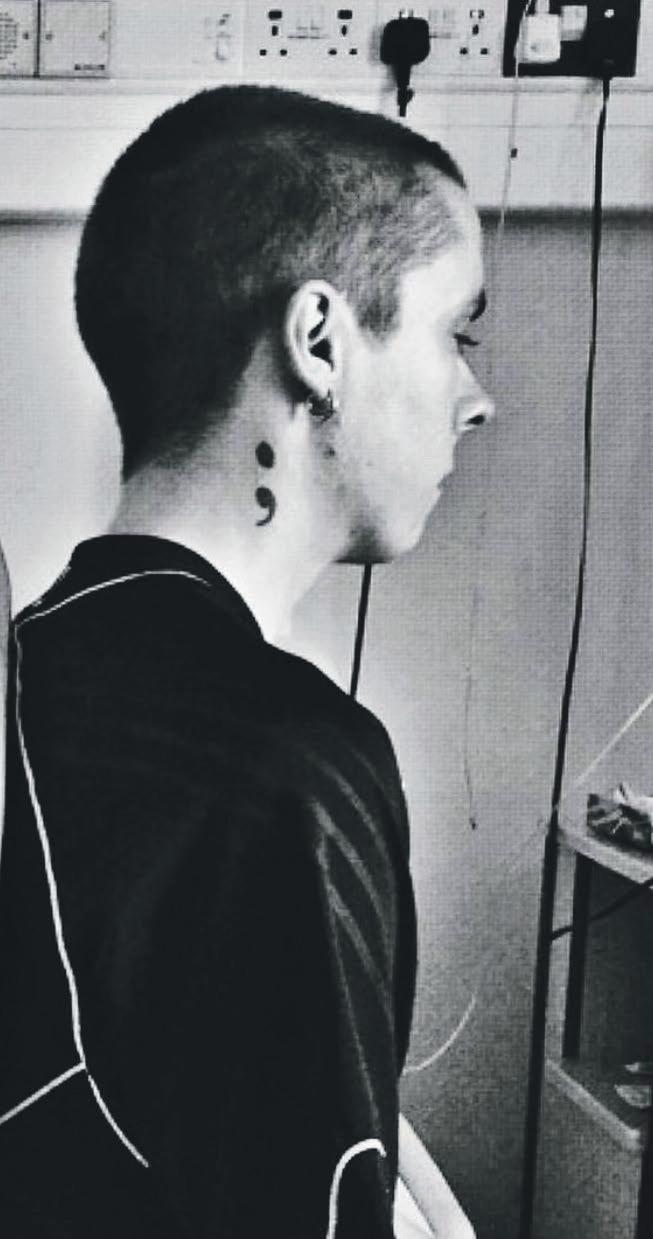
NEVA ELLIOTT DISCUSSES HER CURRENT SOLO EXHIBITION AT LINENHALL ARTS CENTRE.

THE ETYMOLOGY OF bereavement is to “deprive or rob of.” At root, it is something enacted upon us. So too is bereavement’s progeny, grief, arriving not just for the person who is gone but also for ourselves. After my husband Colin died from cancer at 40, I entered a period of grieving, both for him and my lost self.
In my time and culture, without the black parramatta silk or bombazine dress of the Victorians, or Jewish observation timelines, I found I lacked a defined process of mourning. So, I went back to work a week after the funeral and carried on until, after further unexpected and traumatic deaths close to me, I was no longer road worthy. I left my job and returned to my practice. Within death, a part of me was reborn.
This return to making was markedly different from my previous practice. Then, my gaze turned outwards to contemporary society; now, I looked inwards to my own experience. Through my work, I bore witness to my grief in what had become a chaotic, uncontrollable world. Living as material, I began working from a place of transparent vulnerability.

the vast expanse of ocean and sky.
Making acted as a tether to the departed – a way to hold them close – so much so, that I found it difficult to finish pieces. Only when the Linenhall Arts Centre invited me to show with them in January did I finalise the body of work and realise that this was not a letting go. My solo exhibition, ‘How to create a fallstreak’, continues in the gallery until 4 March. The fallstreak of the title is a meteorological term for holes that can appear in cloud formations, referencing the proverbial gap in the clouds I was attempting to create.
While writing the exhibition wall panels, I found myself repeatedly returning to re-work these ‘tombstones’. While demonstratively focused on my own experience, I was also attempting to expand autobiography, to go beyond personal memoir and speak to others about shared human experience. I wanted to create honest, open narratives beside my pieces to enable conversation rather than hide behind distancing art-speak.
FOUR ANNUAL UNITS of temporal measurement; four terms under the bodily condition of grief. Grief is a map of itself that loads in anything but ‘real-time’. All previous conceptions of self crystallise and shatter. This is the cost of love. You were rare in ways that grow evermore apparent as I live on. You were good in ways I still come to terms with; I will likely never be as good. Not that I have to be anything but what I am, I’m sure you’d say. But you deserve to be relived – re-enacted – through me. I am, after all, impossible without you. I live the continuation of the information that lived through you. Whether there is a heaven or not, only that which we enact upon the world – the gyroscopic balance of our deeds and motivations – is what sustains it, and what it sustains. To that end, I won’t let you die any more than you have to.
Childhood is the belief in adulthood itself. The child scries the face of its elder for surety, not realising that it is another child staring back, bigger on the outside. The secret to adulthood is that there is no secret – yet it’s one that must somehow still be kept. I see now why you were a bus driver – you got people to where they needed to go. Bus driving was but one emergent form of your doing so, in the same way that art is mine. You understood this in your final moments, foreseeing my grief process, telling me to ignore the nurses and document whatever I wanted. Pictured are our two bodies: yours unable to breathe lying down, nor able to hold itself up; mine improvising with itself and a pillow to prop you up, breathing for you rhythmically, unknowingly performing the image then captured by your sister. Even now I am documenting. I often say I do what I do out of fear as
much as out of love – for ultimately, ours is the creative material of life itself.
Bodies are the holy sites through which life takes its pilgrimage. Your faith was both what dealt our mutual wound, and what continues to heal it. We are forced to reconcile with where our parents’ beliefs end and ours begin. Bodies are belief systems; systems that are believing. Self-fulfilled prophecies, distinct from our own; phenomenological algorithms simulating themselves, until their every probability in space and time has been enacted.
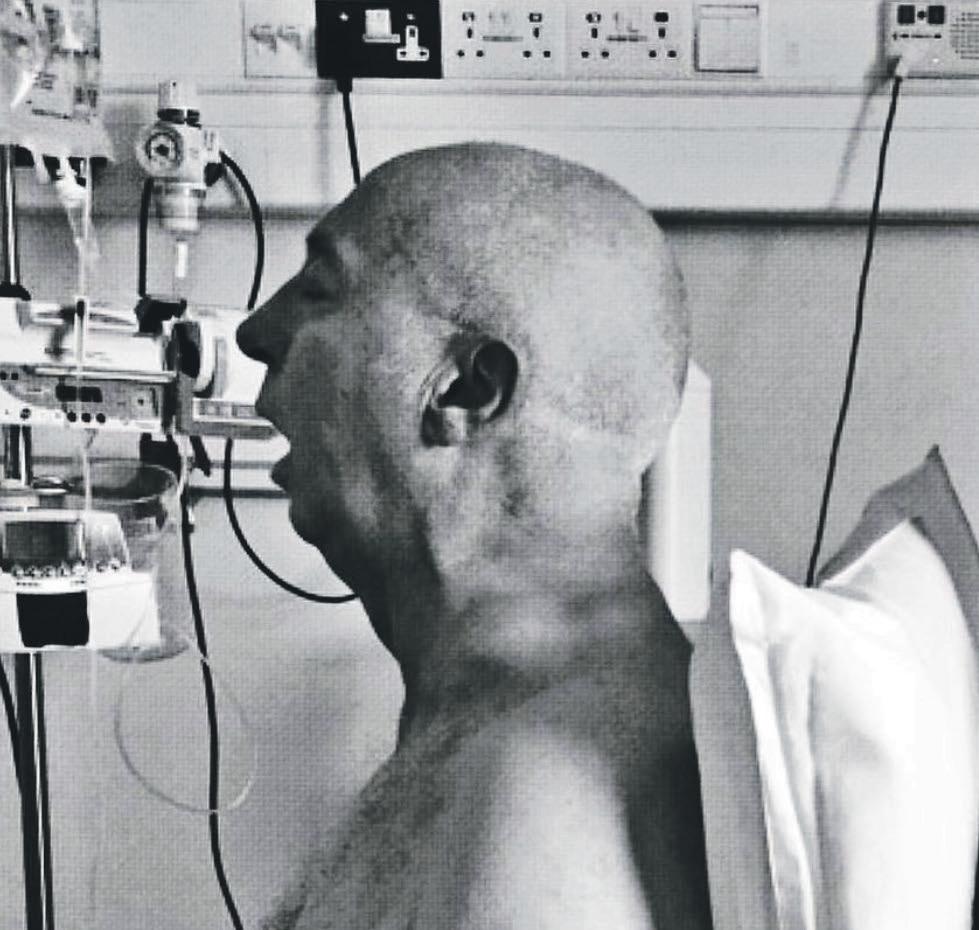
I look for you everywhere. The most meaningful way to do so, I have found, is to deign to look at the world through your eyes. This is how we keep people alive –even those still living – to try to see life from their perspective. In order to see, we must live as they do, according to the self-mythographies they inhabit. We must conceive of the indignations they overcome as they, like us, try to communicate to others the terms on which they might be loved. It is not just how we sustain them, but also ourselves in self-compassion, as we grow from self to self.
We love not only towards a future, but towards a past. We are them now, and they are now us. We are the material. We are the crest of their lives’ incline, just as they were to those before them, in radial waves of living information, emanating outward in every temporal direction.
Day Magee is a performance-centred multimedia artist based in Dublin. daymagee.com
What emerged was a lyrical conceptualism blurring art and life, externalising emotion, responding to relationships and the situation I found myself in, and forming presence that manifested absence. This is a lived archaeology of loss involving people, objects, place and story. Physically, it formalised across photography, text, object, video, sound, and documentation of performative action, such as Sending messages to the sea (2021-22), inspired by lighthouse keepers’ wives, signalling to their husbands from the shore, where I used semaphore flags, the language of the sea, to communicate: “I am here my love, where are you?” to
My practice has become a memorial, a transitional object, a communication and a salve. As I embodied loss, so did my work. To fill a void of absence, to find a way back to myself, to heal and come to a new understanding of my loss, I made art. This allowed me to access a space of mourning and, with it, a restoration of self.
Neva Elliott is a contemporary artist based in Dublin. After ten years as CEO of Crash Ensemble, Elliott returned to her art practice in 2021. Last year she was made an Irish Hospice Foundation signature artist. nevaelliott.com




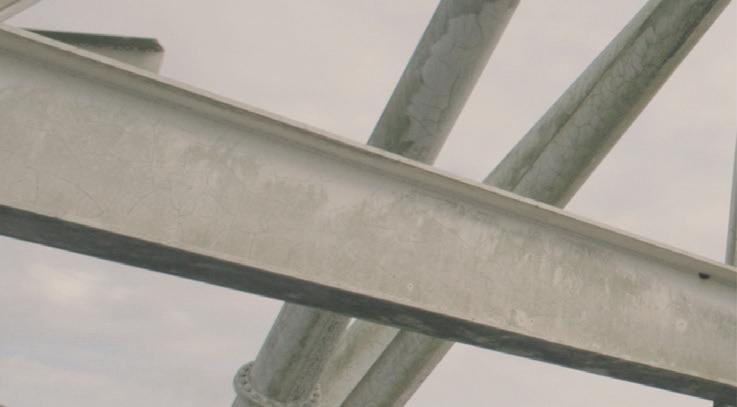

THE SOUND OF hammering echoes from a Georgian house in the village of Killeagh, County Cork. Passers-by stop to pull a book from the free library. In the evening, a glowing circle appears above the river. Inside the house, artists from Ireland and abroad meet for dinner.


This is Greywood Arts. Nestled at the foot of Glenbower Wood, just beside the Dissour River, we aim to position creativity at the heart of East Cork. We are passionate about creating a warm and welcoming space where artists and the community can come together to explore creative processes, to learn and to grow. We do this by hosting artists-in-residence from all over the world, organising community art projects, programming cultural events and offering educational workshops. Our hope is that participants discover a sense of belonging, broaden their perspectives, and deepen their sense of empathy.
Five years ago, Greywood Arts opened its doors as a multi-disciplinary residency space. Located in the main house, it is an artist-run space that attracts those working in the visual, literary and performing arts. We welcome as many residents from Ireland as we do from abroad. We accept applications for our self-funded Creative Process residency on a rolling basis. We frequently support individual artists’ grant applications that include a residency with us, and we are working to broaden our own funded opportunities. We anticipate an open call for a funded residency co-hosted with the National Space Centre this summer. The visual art studio has drafting table and sink, with high ceilings and wooden floors. The Big Studio suits many visual artists, as well as performers, and our cosy writers’ room overlooks the river and is perfect for desk-based creatives. Residencies range from three nights to three months, and we love to support engagement between visiting artists and the local community. Once a week, we have dinner with all of the residents. Outside, two goats and a flock of hens preside over half the old walled garden, alongside newly planted fruit trees and raised beds.
In November 2022, we launched a spectacular light installation at our annual Samhain parade. Villagers carried willow lanterns made during workshops facilitated by Caoimhe Dunn, a member of ISACS (Irish Street Arts, Circus and Spectacle Network). Then, with everyone gathered on the bridge, Circle of Light (2022) was illuminated. Created by VAI member artist Aoife Banville, it brightens the darker winter months; it is a small yet powerful way to lift our spirits and remind us that our community is strong and united in difficult times.
Last November we partnered with the nearby National Space Centre (NSC) to deliver the first Space Fest – a celebration of art and science for Science Week. We hosted accomplished filmmakers Valerie Van Zuijlen (NE) and Emilia Tapprest (FI) who further developed their docu-fiction work, Our Side of the Moon (2022). This story of ‘moonbouncers’, who communicate by bouncing satellite signals off the moon, explores the complexities of modern technology, connection, synesthesia and embodiment. Emilia filmed a stunning movement scene beneath the NSC’s 32-metre satellite dish with Japanese Cork-based dancer, Haru. The exhibition also showcased photographic works made by nearly 100 young people, who learned about morse code and how light travels, during workshops with artist and educator, Róisín White.
We have a busy spring ahead as we grow by leaps and bounds. In April we plan to launch a new multi-disciplinary network for artists in East Cork and West

Waterford. We understood how many artists live in the region, often isolated and unaware of each other. We piloted the project last autumn with the support of both Cork County and Waterford City and County Council arts offices. Members will have access to monthly meetings, half of which will be salon-style sharing events. These will be complemented by talks, workshops and skill sharing. The artists involved in the pilot connected immediately, sharing support and building collaborations. In May, they will have an exhibition and event at Greywood Arts during the May Sunday Festival, which will travel to the Old Market House Arts Centre in Dungarvan later in the year.
May Sunday has been Killeagh village’s festival day for nearly 200 years. Music and dancing on the local landlord’s estate became an annual tradition that shifted to the village centre in the 1920s. The festival had lapsed since 2001, but many locals told us how much they missed the celebration. In 2018, we invited a small team of artists to research the festival and capture local memories, to create a new offering. We moved the fes-
tival back to its point of origin, which is now the community owned Glenbower Wood. In 2021 we created a pandemic-safe art trail throughout the wood with the support of Cork County Council. This year, we are once again incorporating an art trail into the festival, thanks to support from the Arts Council’s Festival Investment Scheme. It will run for two weeks, from 29 April to 14 May, featuring both local artists and four more selected by national open call.
Our most thrilling endeavour this spring is the opening of a new venue, The Coach House at Greywood Arts. For the past year we have been overseeing the renovation of a derelict outbuilding into studios for local artists, an arts education space and a flexible 50-seat event and exhibition space. Supported by LEADER, Cork County Council, and a Fund It campaign, it will be a perfect community resource for the small village.
Jessica Bonenfant is Artistic Director of Greywood Arts. greywoodarts.org
CORK-BORN ARTIST GEORGE Bolster is based in New York City, with a studio just south of the historic Prospect Park in Brooklyn. Establishing a formidable career since the days of art school in his native city in the 1990s, Bolster’s resume speaks as much to how artists now function professionally as to his particular gifts. His profile is transnational with regular exhibitions in Europe as well as the US; when we spoke, he had just opened a solo at Uillinn: West Cork Arts Centre. Bolster’s work has become increasingly interdisciplinary and collaborative, and he is resolutely involved in theories and ideas – a concern with research that has come to underwrite much contemporary art. The artist has also has completed a number of important residencies and a major monograph of his practice, When Will We Recognize Us, will be published by Hirmer Verlag this year. Our paths first crossed at art school back in the day. I am interested to know how Bolster became the artist he now is, and what he thinks about the influences that shaped him.

Brian Curtin: What was your experience of art education in the 1990s – for example, the emergence of the influence of theoretical writings and a shift towards research-based practice?

George Bolster: I studied painting at Crawford and Chelsea colleges, and it is telling that I didn’t do any painting at the latter. In Cork the teaching was formalist and there seemed to be a fear of talking about art. But in London there was much more interest in art discourse. When I began at Chelsea, I was defensive because of my earlier experience, to the point that tutors took me aside and told me they were there to help me! I relaxed and taught myself to be supportive and constructive not dismissive. I was nicknamed Tristram Shandy, a figure of eccentricity.

I initially encountered theory through reading publications by Zone Books and this led me to conceptual art. But, with conceptualism, I felt there was a flattening of the poetic with a dry language and execution. Ideas of research-based practice became more appealing and a lot of my work has consequently been collaborative, whether working with musicians or scientists. With conceptualism, I felt restricted, though that may just be me!
BC: What was the London art scene like when you graduated?
GB: It was the time of the YBAs (Young British Artists) who had come from Goldsmiths as I was finishing my MA at Central Saint Martin’s. Goldsmiths’ graduates got most of the attention, with art dealers at their graduation shows, but I did exhibit at smaller, alternative venues including screenings at Chisenhale Gallery. I never felt like a British artist, which was the brand, and had a problem with the term being celebrated due to colonial history. I didn’t try to fit in.
BC: A longer interview could unpack that. But at what point did you shift from ‘recent graduate’ to professional?
GB: I curated an international group exhibition ‘Multiplicity’ at Fota House in Cork in 2004 with Arts Council funding. This project continued for over a year because the final venue was Derry’s Context Gallery. Through this experience, I developed practical skills in all aspects of art administration, including pre-emptive problem-solving. ‘Multiplicity’ gave me a sense of being proactive and building community – something I had always yearned for, as being an artist can be lonely.
BC: How did your move to the US in 2008 play out in this respect?
GB: I initially moved to San Diego and responded to the sharp change by curating TULCA Festival of Visual Arts in Galway, which I titled ‘i-Podism: Cultural Promiscuity in the Age of Consumption.’ I worked with artists whose work had impacted me during my move, with the iPod as a metaphor for a personal digital library of important sights. It was also an auto-critique of the figure of the curator by removing any implicit sense of objectivity and embracing subjectivity – again, being proactive while pushing against expectations of who or what we are. Moving to the US was also important because I began the shift away from the deconstruction of Christian imagery in my early work.
BC: Was there a catalyst for that?
GB: I completed the Robert Rauschenberg Residency and then a residency at the SETI Institute – an organisation that investigates extraterrestrial life. I discovered Rauschenberg’s environmental activism in the 1960s and how, alongside Warhol and others, he created the ‘Moon Museum’ which was attached to Apollo 12 in 1969. I then visited NASA to research a project that digitises pre-Apollo mappings of the moon and began to further wonder about the conservation of artworks for the future. This project was housed in an old McDonald’s building because the ventilation system was perfect for archival storage. Essentially, I became interested in the need for us to evolve less damaging forms of technology for our cultural longevity in the universe.
BC: The installations you recently showed at Uillin: West Cork Arts Centre use large Jacquard tapestries with epic landscape imagery.


GB: I began with Jacquard in 2014 but the early experiments failed, and I returned to the medium in 2017. Back to your question about research, during the time
of the residences, I met a scientist who spoke about the importance of failure in experiments. The concept of failure as a requirement for discovery gave me a more profound insight into, say, da Vinci than any study of art history ever could.
The Jacquard machine was the basis of computational language, a process of programming resulting in something akin to an analogue/digital image. I am interested in making a virtue of glitches, staging a sort of dysfunctional relationship between myself and the machine which is analogous of human relationships to the environment.
BC: Finally, how have your evolving interests affected you personally? During your introductory talk with Seán Kissane at Uillinn, you looped back to religion.
GB: I grew up in an atheist household. Religion depoliticises how you interact with the environment. If you think you’ll go to heaven, why care about the planet now? Belief, or unquestioned knowledge, causes us to stagnate, to exist in stasis. And, let’s face it, humans are a lot older than their gods.
George Bolster’s solo exhibition ‘Communication: We Are Not The Only Ones Talking…’ ran at Uillinn: West Cork Arts Centre from 7 January to 11 February.
georgebolster.info
Brian Curtin is an Irish-born art critic based in Bangkok. He is the author of Essential Desires: Contemporary Art in Thailand (Reaktion Books, 2021). brianacurtin.com

Miguel Amado: In your projects, you seem equally invested in enabling reflection about your own identity and bringing different people together. Would you agree?

Alice Rekab: I think that’s really astute. In the Ireland I grew up in, I was very much in the minority in a lot of ways. I didn’t have any mixed-race friends at all, even when I went to college. It was only when I moved to London to do my PhD that I met other artists of various heritages who were making work – or even just looking at the world – through the lens of being mixed race.
MA: Ireland was very culturally homogeneous in the 1990s.
AR: I distinctly remember being 12 or 13 years old and suddenly seeing other Black people in Ireland for the first time – for example, a woman at the back of the bus that I couldn’t identify. I recall wanting to speak about that, but also feeling this strange sense of alienation, because obviously there aren’t that many Sierra Leonians in Ireland, and I had no way of knowing which part of Africa the woman was from or had connections with. Navigating all the nuance of difference and African-ness was a learning process, particularly as a young person growing up in a mono-racial society.
MA: Your recent project, ‘Family Lines’, which included an exhibition at The Douglas Hyde and multiple events in and beyond the gallery during 2022, engaged with this inquiry in two ways: conceptually, through your works, and practically, at grassroots level, as you facilitated encounters with others.
AR: ‘Family Lines’ was about an internal, subjective conversation
MIGUEL AMADO INTERVIEWS ALICE REKAB ABOUT EVOLVING THEMATIC CONCERNS IN THEIR PRACTICE.
that happens through clay, the paintings, the images, the albums. It constituted a place of self-discovery, something deeply personal that then becomes political. But it was also about making a space to share my experience, specifically of intergenerational migration, as much as enable its examination with and through multiple voices. Thus, it also allowed me to reach out to a community with whom I wanted to connect and enable the public to engage with.
MA: It is as if the project operated as a platform not only for your works, which engage with underrepresented narratives, but also for Black Irish creatives, who are still part of those same underrepresented narratives.
AR: My aim was for them to be heard by others and to be heard by one another, showing that one’s voice isn’t the only voice – that one is not alone – and understanding that the conversations we have with one another are a way of dealing with invisibility or erasure. When you are raised in the West, a lot of ignorance is ingrained in you, because we’re not taught otherwise. I didn’t learn anything about my father’s family, or what Sierra Leone was, or about West Africa through school. And if who one is does not matter, that has an impact on one’s sense of belonging.
MA: This is why you often talk about the emotional and intellectual impact of your first visit to Sierra Leone in 2009.
AR: I always knew I was Irish Sierra Leonian because I had a close relationship with my grandmother, but that was in the vacuum of mono-racial Ireland, and thus I only understood my heritage in relation to her. The first time I went to Sierra Leone, I was in her company, and that was the moment I realised I was Irish Sierra Leonian in relation to her within a Black majority context. That was revelatory yet difficult, as I became aware of the complexity of my light skin tone. When people there looked at me, they didn’t see a mixed-race person, even if I spoke Creole or understood the nuances of local behavior. And I also became aware of the privilege I had, just from having been born in Ireland. So that trip was the catalyst for the consciousness of being myself, appearing to me in a mirror larger than the borders of my inner world.
MA: You seem to translate this experience into your works, whether they are 3D pieces, paintings, or digitally collaged lens-based imagery, and particularly when you use materials such as clay.
AR: The use of clay emerges directly from my body and from the subconscious as something that is almost impossible to articulate verbally. The material enables that which feels outside of language to manifest physically, as it has this kind of primeval quality. The animals I sculpt are my interpretations of the souvenirs that were in my home, objects that had been brought over by my father’s family in the 1960s as symbols of their culture. They allow me to critically examine mainstream Western representations of Africa as a place where wild and unknown things live, as I play with the emergence of an African tourist industry for the Western gaze and the need for immigrants to connect with their geographies of origin through material culture.
The idea of mapping ways of understanding – that’s where the paintings come in. I use boards, sometimes reclaimed, as the surfaces onto which I apply a mixture of clay, images, and oil stick, and there’s a lot of cutting and texturising, which in a way operates like a sort of fractured, temporal diagram of life. For instance, Our Common Ancestor: Five Panels of Enmeshed Historical Narrative (2022), which was on view at The Douglas Hyde, suggests a quantum timeline in which different times are superimposed on one another and create meshes that get read through in different ways; they are a short-circuiting of human history and personal and cosmic histories. There are these master stories, but
there are also intimate ones – for example, a miniature picture of my grandmother sitting solitary at a table next to a vast depiction of a fossil and a stellar explosion. Certain stories are valued differently, depending on your proximity to them.
The digital collages reconfigure all the elements. They often feature family photographs, which I may bring together with other images. And then there’s a digital drawing aspect that creates the links – both literally and symbolically – as well as areas of intensity through mark-making of what seem like coronas around certain figures or objects, as a means to bring to life dear people or beloved animals that are dead.
MA: Your latest exhibition, ‘Mehrfamilienhaus’, is on view at Museum Villa Stuck in Munich, and features works that, while speaking to the core of your concerns, look at new areas of interest.
AR: ‘Mehrfamilienhaus’, or ‘A Home to More Than One Family’, continues my exploration of the family unit, but expands it in dialogue with this site, Villa Stuck, which was an artist’s house, and where other artists now exhibit. I produced this exhibition while in residence in Munich in the summers of 2021 and 2022. Thus, I am reflecting on the notion of being a transplant, of being brought into a location and trying to establish a connection with its people and territory. I am also exploring questions of artistic inheritance – for example, what it means to be the child of an artist, or to live with an artist. At Villa Stuck, Franz von Stuck’s studio was the grandiose room, while the family’s living quarters were modest. In my home, my father’s studio was in our front room, and when he was working, he couldn’t be spoken to, no matter what was happening. So I am looking at this tension between art and life, and the psychology of being an artist. And thinking about Villa Stuck as a home to more than one family: the von Stuck family’s story and presence within the architecture, and my family’s story, which I intertwine
with that one.
MA: So you are very intentionally engaging with a house that belonged to an artist, and considering dialogues between artists and generations, while keeping your key themes – mixed-race identity through African heritage, migration, displacement, monoculture –in tension as well, although perhaps less overtly.

AR: Bavaria is white, wealthy, and conservative. I am curious to see how the team at Villa Stuck facilitates engagement with African communities in the city. In the circles I moved around, while in residence in Munich, I haven’t heard questions of diversity or the experience of being a migrant. On the other hand, engaging with something as intimate as ‘home’– as an architecture, a territory – is a political statement. In the West, there is a conversation, if not an understanding, among professionals and certain audience segments around the historic subalternisation of practices that do not adhere to the modernist framework, which is a Western framework. But whether this conversation could connect with broader issues in Munich (and anywhere in Germany or the rest of Europe) as an environment for migrants, remains to be seen. That is the common task to which I hope to contribute.
Miguel Amado is a curator and critic, and director of SIRIUS in Cobh, County Cork. siriusartscentre.ie
Alice Rekab is an artist based in Dublin. alicerekab.com
Rekab’s solo exhibition, ‘Mehrfamilienhaus’, continues at Museum Villa Stuck in Munich until 14 May. villastuck.de


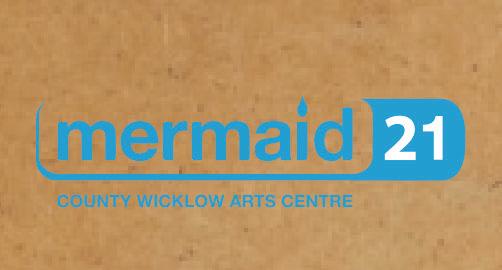









Edition 66: March – April 2023



Hugh Lane Gallery
1 February – 8 August 2023
MAKING A NOTE of the exhibition title, I wrote “Reconstructing Modernism”, before quickly realising my error. ‘Mondrian’ and ‘Modernism’ may be synonymous, but until I saw Mondrian’s paintings for myself, I mostly associated them with advertising. The painter’s primary colours and no-nonsense straight lines sold everything once, except for themselves, of course, which, untethered from their canvas supports, meant precisely nothing. In filming a reconstruction of the artist’s Paris studio (circa 1921 to 1936), John Beattie reminds us of the paintings made there, but also of everything that has happened since – our fables of reconstruction, our endless era of aftermath.
“Who’s afraid of red, yellow and blue”, Barnett Newman famously asked, riffing on Edward Albee, while confronting his audience with acres of flat colour. “John Beattie is”, I might flippantly answer, on the evidence of the five large photographic prints included in his pristine show. Respectively titled, Black, White, Red, Yellow and Blue (all 2022), these hand-printed photographs, covering the spectrum from pale to dark, are resolutely grey. Taking a closer look at the labelling, one learns that the flat, square shapes (all are subtitled “Depicting oil paint on canvas”) of Black and White have been shot on colour film, while the series named for the primaries have been shot on monochrome. “What you see is what you see” Frank Stella said, but it’s not always as simple as that. Newman and Stella both owe a debt to Mondrian, but then, we all do.
Primarily a utility, artists’ studios can also have mythic dimensions, especially when transformed into a repository. In his writing about archives, Achille Mbembe suggests that the reassembling of remains can be a kind of miracle, “bringing the dead back to life by reintegrating them into the cycle of time.”1 This resurrection comes at a price, though, as the spectre (as rem-
nant of death) is removed from their own lifetime and put into the service of history. However sensitive and respectful – and Beattie is both – when artists make work about other work, a paradox inevitably ensues; the original is highlighted, but only to be overwritten.
The heart of the exhibition is an hour-long film showing the arrival, construction, and eventual deconstruction of a life-sized version of Mondrian’s former workplace. The film is beautifully shot and edited – put together like the flat-pack version of the building itself – and has the unhurried atmosphere of real time. The surround sound makes you feel like you’re in the space of the reconstruction, sharing in the verbal exchanges, the thumps and whizzes of assembly. There is an emphasis on measurement, as we see a tape drawn across the empty floor and the careful placement of hand-drawn marks. By circumstance, we are invited to think about the reconstructed Francis Bacon studio, permanently housed in the Hugh Lane. Bacon must be smiling at that forensic accounting of his trashy den, its catalogue of dust, but like Mondrian, he knew the surfaces that counted.

On the hangar-like film set and site of the reconstruction, a stocky figure, bald and sporting a bluestripped Breton top, is in charge. He looks strikingly like Pablo Picasso. Is this merely a coincidence? The imposter is Frans Postma, Dutch architect and founding director of the STAM foundation.2 Calm and methodical, he orchestrates the building process – one inevitably compared to the compositional process of Mondrian – and offers final touches like the delicate placement of the artist’s pipe and spectacles. We see him dressed differently later on, but I couldn’t shake the impression that Pablo was roaming about in Piet’s careful house.
Mondrian, in his own way, was also an architect, but
his best buildings were entirely facade. In his actual atelier, the living, breathing Mondrian was fastidious, practicing the fox-trot in the mirror before getting down to work in his neat, white coat. In the glow of Beattie’s film, I reminisced about seeing his paintings for the first time in New York. I was extremely jet lagged, but it was an afternoon of revelation upon revelation. You have to look carefully, but when you do, you see that his fragile, human geometry is more real than any reconstruction can convey. You have to look hard to see, and John Beattie makes a place for that.
John Graham is an artist based in Dublin
1 Achille Mbembe, ‘The Power of the Archive and its Limits’, in Carolyn Hamilton et al (eds), Refiguring the Archive (Dordrecht: Kluwer Academic Publishers, 2002) p. 25.
2 STichting Reconstructie Atelier Mondriaan (STAM).
Belfast Exposed
2 February – 18 March 2023
IN LATE 2017, socially engaged artist Anthony Luvera presented ‘Let Us Eat Cake’ at Belfast Exposed – an exhibition of photographs created by the artist and LGBTQ+ people living across Northern Ireland, which I reviewed at the time. The artist has returned to the gallery this year with ‘She / Her / Hers / Herself’, presenting more in-depth work on Sarah Wilson, one of the participants in Luvera’s previous series.
Luvera’s self-directed portraits of queer people in 2017, against the backdrop of the bigotry of the Democratic Unionist Party’s enduring anti LGBTQ+ stance, were intimate yet provocative. This newer body of work continues the humanised provocation of simply existing as a trans person in Northern Ireland, and is a culmination of the continued collaboration between Luvera and Sarah. This exhibition is timely; mainstream news outlets are stoking a moral panic in which trans people are the cultural collateral in the right’s attempt to put a wedge in feminist and queer communities. Consequently, this exploration of Sarah’s experience as she navigates her evolving identity, has become even more political.
Griselda Pollock reminds us that we cannot remove our identities from our context: “all socialised subjects participate in socially constructed positions that are endlessly undone by the fundamentally fractured and equivocal nature of subjectivity and sexuality themselves.”1 Pollock offers that the cultural subject is in constant process, and that psychoanalysis is embedded in our understanding of culture and ourselves. Artists often use that knowledge to play with ideas of self-image and desire as a woman.
On the surface, Luvera’s photographs chart Sarah’s new life, her personal milestones, her self-awareness, her careful joy in her new way of being, her new job, and her evolution as a beautician. Photographs capture the visible surface and use a range of approaches to hint at something below it. Luvera’s approach is dialogical, continually referencing the construction of the image. He often features himself in mirrors, reflections, and backgrounds in deliberative portraits, breaking the fourth wall as a way of negotiating authenticity. The inclusion of images made with Luvera and phone selfies is another strategy the photographer uses to corral deeper reading.
The Luvera-assisted videos are reminiscent of ubiquitous YouTube make-up tutorials. They rely heavily on the contemporary lingua franca of social media, but what do they add? The slow, contemplative speechless moments in the videos are the most intimate of all the works. They allow the process of looking to unfold between us – the image maker, the subject, and the viewer. There’s a brightness from the make-up ring light that offers clarity and lucidity; on occasion a subtle smile grows on Sarah’s face, as we hear them interacting. These powder-pop coloured films remind me of Rineke Dijkstra’s videos of teenagers in nightclubs, The Buzz Club, Liverpool, UK/Mystery World, Zaandam, NL (1996-97), where decontextualised moments are isolated to increase our engagement intensity.
There’s an über performativity in some of the other images, collaborations and self-portraits alike, which seem to move us away from Sarah’s personhood. Much of the context is abstracted, which feels unlike Luvera’s previous work. There’s a notable lack of any other people, even hinted at in the background, bar Luvera – not even the occasional blurred co-worker of Sarah to suggest her interpersonal realisation as a new woman beyond the lens or the private domestic sphere. This skips over one of the things that LGBTQ+ survival relies on – the recognition of our interdependence in and outside of our communities. This would be too high an expectation for one portrait, but in a large series of works, it is clearly an editorial decision.
That said, there are some absolutely stunning images, one reminiscent of a Nan Goldin portrait, depicting
Sarah in a car, with the colourful streetlights outlining her profile and hinting at something beyond four walls. The image of the neon makeup palette with Sarah in the mirror is glorious, but also deft and touching, while the window-lit portrait of Sarah in her voile-sleeved black dress gives us Almodóvar heroine-at-a-funeral realness. Then we have Sarah in full ‘sofa-burrito’ mode, wrapped in her duvet and offering one of the sweeter moments of the series.

Anthony Luvera has said that he sees this body of work “not only as a representation of one individual’s experience of their trans femininity but as a reflection on the way cultural influences can shape and determine the expression of gender and identity more broadly.” The intimacy in the five-year journey that Anthony and Sarah have made together and shared with us is insightful, beautiful and tender. The best parts offer contained flickers of trans joy in self-preservation.
Emma Campbell is a Research Associate at Ulster University, working on Reproductive Citizenship with partners in Trinity College Dublin. Emma is a member of the Turner Prize-winning Array Collective and has exhibited in international solo and group shows. Emma is also co-convenor of Alliance for Choice. emmacampbell.co.uk
1 Griselda Pollock, ‘What Women Want: Psychoanalysis and Cultural Critique’ in Nancy Princenthal (ed.), The Deconstructive Impulse: Women Artists Reconfigure the Signs of Power, 1973 – 1991 (Munich: Prestel Verlag, 2011) p. 74.


12 January – 28 February 2023
IN THE MID-1800s, the newly formulated second law of thermodynamics undermined a long-held notion that the universe is eternal by predicting that its lifespan would end in a ‘heat death’. Written about in newspapers, this harbinger of cosmic doom captured the popular imagination, while introducing the notion of ‘entropy’ as a measure of disorder in an isolated system. The universe at maximum entropy, with all of its energy dissipated through doing work, would reach a homogenous state.1 There could be no order, since nothing would remain to be understood in relation to anything else. It would be a cold, dark, meaningless place.
This brought new insight to familiar scenarios, including why, over varying timescales, things degenerate, homes become untidy, people age and die. A hundred years later, re-assigning ‘entropy’ to associate with ‘noise’ and ‘information’ seemed to circumvent the gloomy prognosis – until it was realised that dissipation would result from the work required to dispose of newspapers, and the stuff of information generally, since it doesn’t disappear when no longer needed.
Coincidently reading about this later take on entropy proved a useful primer for a visit to ‘A Demarcation of Time’, with its evocations of ‘slowscapes’ and waste accumulations. Bearing titles such as Matter Out of Place, Kelly’s works variously shed light on the effects of over-production, reflect on how resources and waste are dealt with, and probe the forms materials can take as they persist over years, decades, millennia. Made using salvaged wood, bitumen and other discarded or reconstituted products, the exhibits mobilise different parts of the gallery through a choreography of leaning, resting and hanging.
The artist’s reference point is the Split Hills Esker in County Westmeath. Eskers are narrow elevations that wind through flatlands, and the term is derived from the Irish eiscir, meaning ridge. Formed through processes involving glacial meltwater, they are comprised of strata holding deposits of sand and gravel. Despite fostering unique biodiversity as wildlife corridors and sites of native woodland, in the 170 years since the conception of the ‘second law’, they have been “widely extracted and dismantled” to supply aggregate to the construction industry.2
Kelly’s show mirrors the activities of a reprocessing plant, now located at the site’s disused quarry. This repurposes matter that would otherwise go to landfill, and the artist’s parallel reworking of form and function (exploring possibilities of change over time) permeates the exhibition.
At its centre, the floor-based A Temporary Iteration, Stage 2 (2020-23) is a huddle of birch-ply polyhedrons, arranged as though deposited naturally. Referencing the calcite crystals found in eskers, they allude to the fallow land on the steep sides of these ancient landforms, which, as Kelly has remarked, is “demarcating a space for something beautiful to happen.”3 Bitumen-printed flora, secreted in ‘cracks’ between crystals, hint at new life springing from dormant potential. Also built-in, a tiny looped video pans over waste material embossed with honeycomb patterning, before ending with a sequence in which a bee lands on a scabiosa flower. Balancing resiliently as the plant pivots in the wind, its micro activity becomes emblematic of macro precarity.
Nearby, a copper etching and aquatint from 2022 shares the exhibition’s title while demarcating time through the multi-phase process of printing. Suspended on a white ground, Kelly’s fine-line mark-making and monochrome tonal patches manifest that most entropic of residues and familiar memento mori – a bag of dust. There’s no Such Thing as Away #2 (2023) is one of three layered compositions made from substances that are discarded but not gone. Its shadowy cinders, displayed in a bell jar, look organic but are revealed as plastic in the materials list. Two other iterations present

a shard of glass as a flower-like thing of beauty and a fragment of brick as a worn-smooth pebble.
‘Noise’ is introduced to the looking process by distortions in the glass jars and deliberate smudges in the bitumen-on-plywood piece Ceaselessly Shifting (2023). Here, this quality, along with the retained dot-matrix of the screen used in its making, recall the experience of reading newspapers, when ink invariably ends up on fingers. These details combine with the grain of the support to lend nuance and interest to its flat surface. At a time when the media is awash with stories about the future of the planet, Kelly’s measured approach to engaging with pressing issues resists being shouty. Instead, in her work, the excesses of our time are contrasted with the potency of pared-back means.
Susan Campbell is a visual arts writer, art historian and artist. susancampbellartwork.com
1 The term ‘dissipation’ is used here to describe occasions in which energy is irreversibly wasted. Rather than being transferred to useful energy stores, it is lost to the surroundings.
2 Exhibition text (rhagallery.ie)
3 A comment made by the artist during an online public conversation with Dr Robert Meehan on 10 August 2022, as part of her exhibition ‘A Temporary Iteration’, at SIRIUS.
ANN MCVEIGH AND Ken Bartley, the team behind ArtisAnn Gallery, are no strangers to the NI Science Festival or indeed science for that matter – Ken has a degree in physics. Every February sees them contributing a welcome contemporary art component to the festival and, with the inclusion of Raymond Watson’s solo show ‘Apis Mellifera’, this year is no exception. As I arrive at Watson’s show, Ann asks someone just leaving if she listened to the recordings of the bees. “No, I’m scared of bees!” she replies. Everyone laughs and I think to myself, as I ascend the stairs to the first-floor gallery space, “well, I’m not scared of bees…”
Taking its title from the Latin name for the European honeybee, the show focuses on the activity of beekeeping and comprises two audio pieces, nine oil paintings, and three bronze castings. Watson is perhaps most associated with the latter medium ever since the initiation in the early 2000s of his ongoing body of work ‘Hands of History’, in which the artist casts in bronze the hands of key figures involved in the Peace Process.
I begin with the paintings. Each one is self-contained, vibrant and centres on a single aspect of beekeeping. They provoke an immediate sense of nostalgia; something about their style and clarity of vision takes me back to the encyclopaedia illustrations I would pore over as a child. The visual affinity with science imagery is fitting, even beyond the show’s inclusion in the science festival. The paintings have a schematic quality in their drive to illustrate and explain ideas and phenomena, especially ones which cannot be seen with the naked eye. For example, The Tree Hive shows a swarm of bees that have formed a home inside a hollow tree – a natural habitat in contrast to the beekeeper’s functional construction depicted in The Blue Hive. The bark of the tree has been ‘cut away’ by the artist, seemingly seared clean off with edges still glowing red. It enables us to ‘see’ inside the tree’s hollow trunk where worker bees crowd around the queen, like seeds dotted about the core of some exotic fruit sliced open.

In The Dances various shapes are scattered over an intense orange background – some like raised insect wings, others like cross-sections of apples or simple concentric circles. They show the pattern of steps that bees perform to communicate to the rest of the hive where the best nectar pickings are to be found. Again, Watson illustrates something which cannot be seen;
these dances take place in the darkness of the hive, the visual pattern of no concern to the bees who interpret solely the rhythm and vibrations. Above the ‘dancefloor’, in the upper section of the canvas, is a pattern of lines and dots – it’s like a dance-step diagram but is actually the molecular structure of honey. In the Cell is yet another example, here illustrating stages in the bee life cycle from egg to larva, each step depicted neatly in sequence.
The stars of the show are the three bronzes – The Brood Frame, Three Queen Brood, and Super Frame –frames from working beehives which Watson has cast in bronze. The oblong pieces dangle from wooden supports, suspended much as they would be in the hive, like filing cabinet dividers. Watson is rightly proud of the process he has devised to turn these extraordinarily delicate objects into solid artefacts. Hundreds of honeycombed cells are visible on both sides of each frame, from queen cup cells to worker and drone cells to those brimming over with honey. Yet each has its own character, from the almost fractal energy of the first, to the softer topographical undulations of the second brood
frame, and to the smallest yet most voluminous of the three – the beekeeper’s ‘super’ frame from which honey is harvested. Colours range from a rich, warm brown to a shimmering polished gold. They provoke questions about the co-authorship of their creation, the human-animal relationships at play, and the organic-industrial nature of this 10,000-year-old activity. Even to the non-apiculturist’s eye, the works are intricately fascinating and beautiful.
The two audio pieces, Bee Life and The Swarm (of five and four minutes in duration respectively) are short immersive journeys: the former a droning bee sound from which manipulated samples gradually emerge and coalesce into a melody; the latter more abstract, moving from birdsong to a single bee, to innumerable bees and returning to birdsong at its conclusion. On leaving the gallery, I pop my helmet on and, while unlocking my bicycle, something brushes my cheek – I flinch, jerking my hand to my face. It’s not some stray February bee –just an unfastened strap tickling my cheek and making me question my earlier assertion…



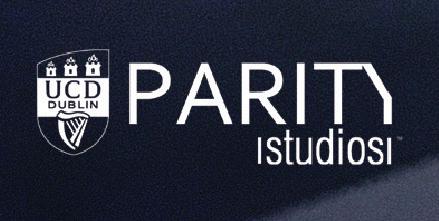
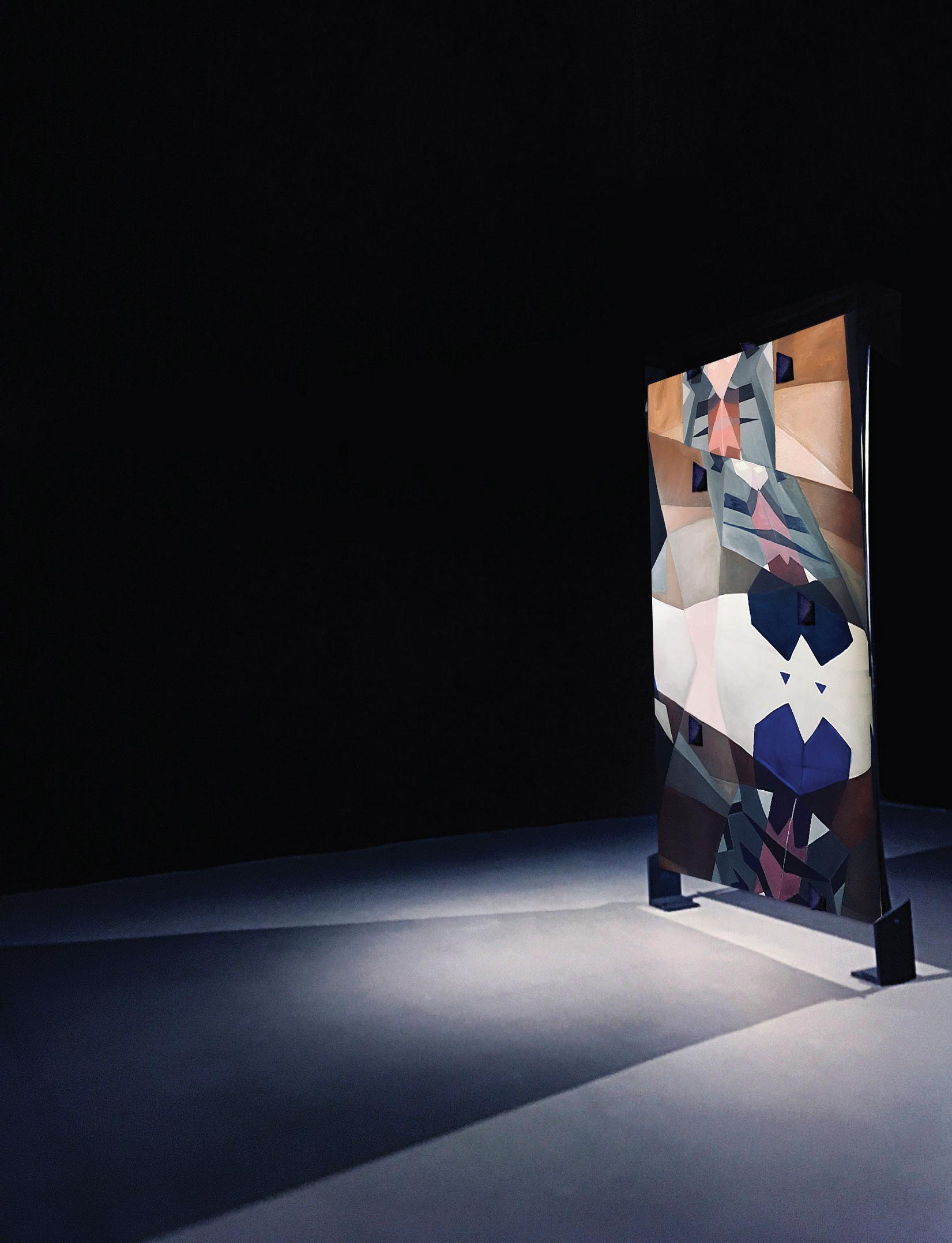
Sarah Browne, Rhona Byrne
Lorna Donlon, Emma Finucane
Maria McKinney, Michael McLoughlin
Meadhbh O’Connor, Rosie O’Reilly
Sonia Shiel
25 March – 28 May
Municipal Gallery
dlr LexIcon, Dún Laoghaire dlrcoco.ie/arts / Tel 01 236 2759
A GROUP EXHIBITION FEATURING WORK BY MARK CLARE, CLODAGH EMOE, ERIN REDMOND, ROSIE O’REILLY AND TREVOR WOODS
30 MARCH – 27 MAY
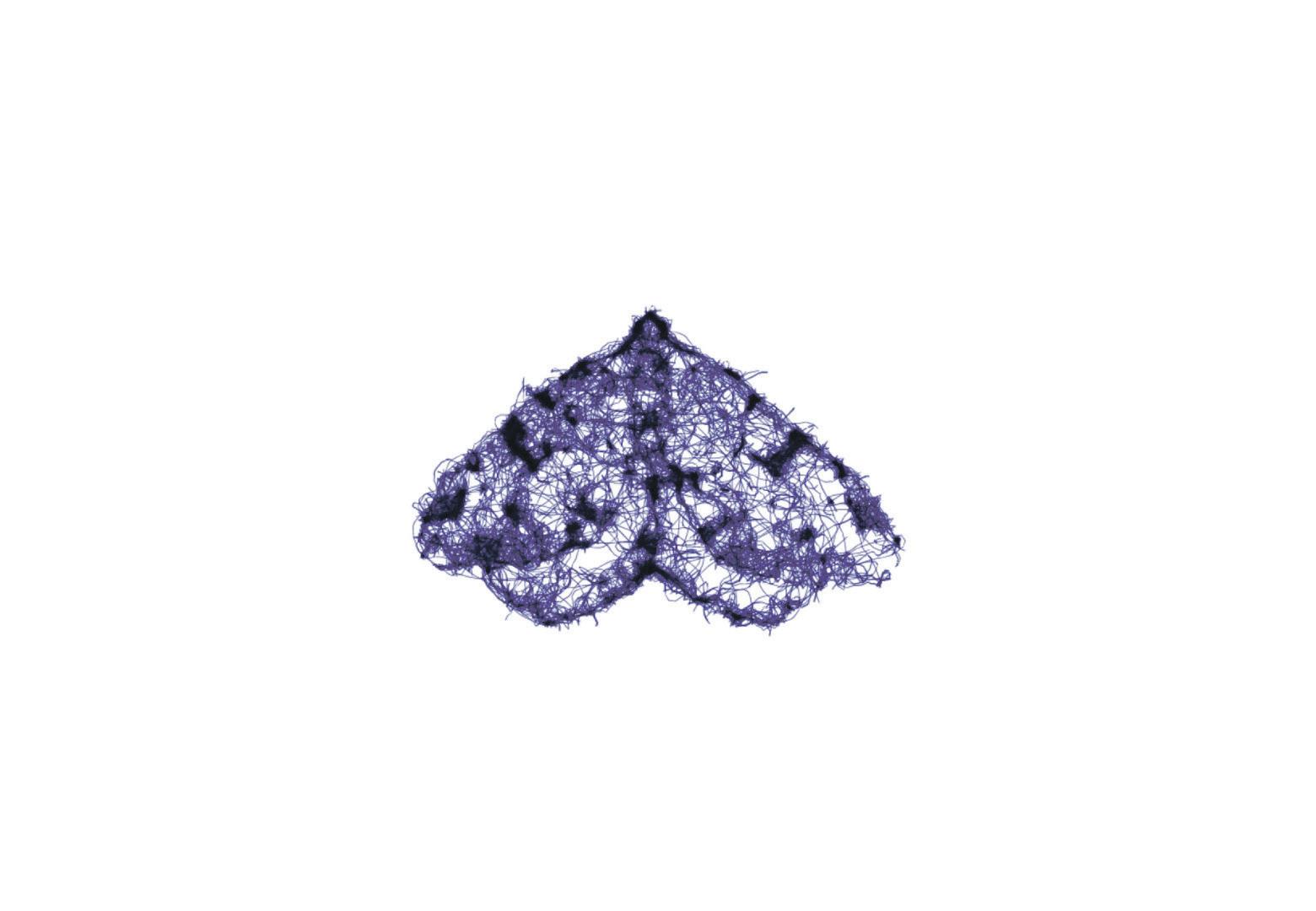


CURATED BY SHANNON CARROLL
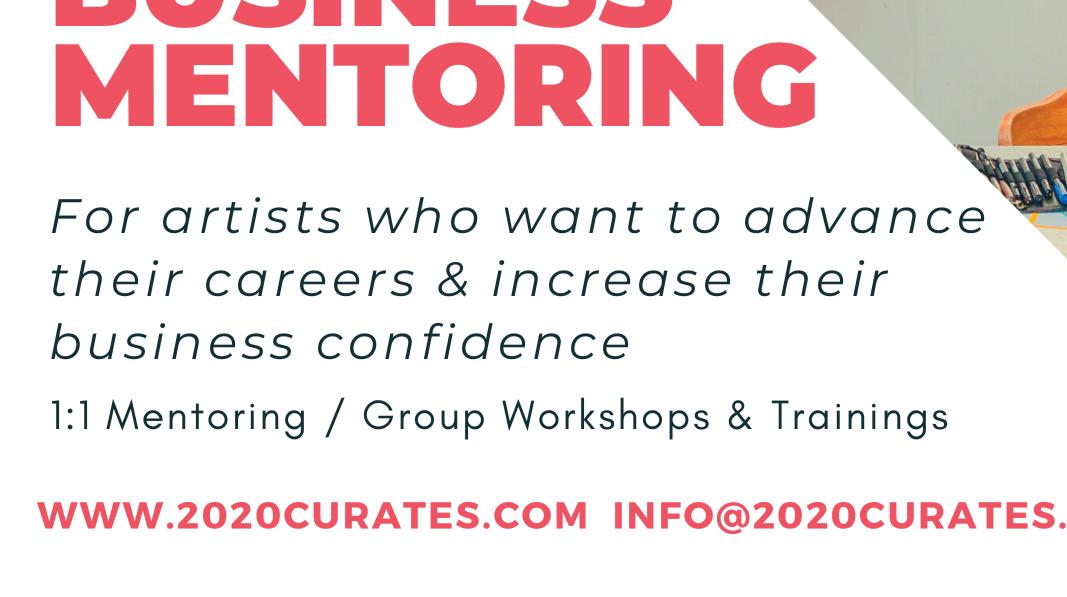


Gallery opening times:
Monday to Saturday 10am to 6pm
Admission Free
The LAB Gallery

Dublin City Arts Office, Foley Street, Dublin D01 N5H6
Tel: (01) 222 5455
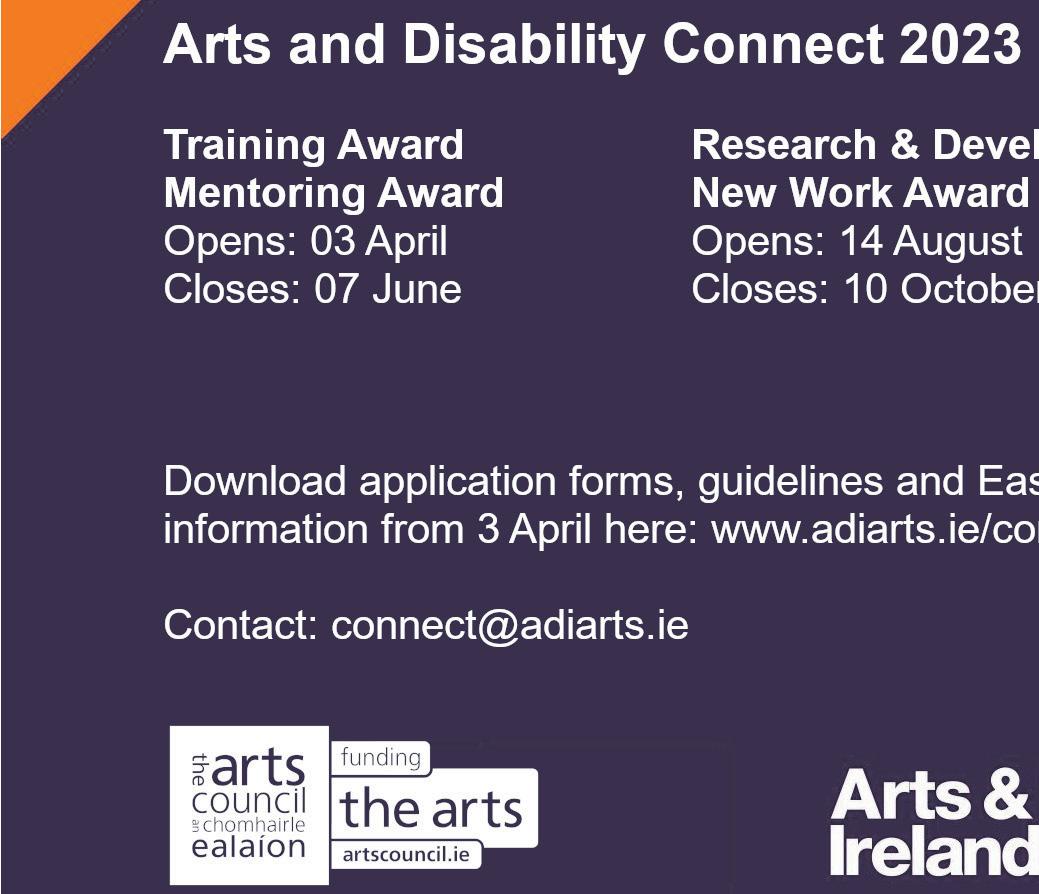 Sonia Shiel, The Vertical, 2019. Installation Shot. Void Gallery, Derry
Sonia Shiel, The Vertical, 2019. Installation Shot. Void Gallery, Derry
MIGUEL AMADO AND GEORGIA PERKINS OUTLINE A SOLO SHOW BY OFRI CNAANI PRESENTED AT RAMPA IN COPRODUCTION WITH SIRIUS.

THE ARTIST OFRI Cnaani addresses the omnipresence of the digital in everyday life. Specifically, she considers contemporary society’s reliance on algorithms as related to data generation, collection, archiving, and monetisation, and the inevitable accompanying questions of control and extraction in the context of so-called cognitive capitalism. For example, the photographic series Statistical Bodies (2021) investigates how the body is mapped as it has become networked by data aggregation and analysis – quantified through massive accumulations of information on purchases made, bank accounts maintained, and online platforms used.
Cnaani draws from educational protocols such as research and teaching to examine various institutional settings. Having previously worked in the museum sector, she often incorporates the docent position into performances that confront the ways in which knowledges and histories are both produced and communicated. This strategy informs the exhibition ‘Leaking Lands’, which features a 2022 film of the same title, premiering on this occasion, and Testimony of Things (2022), a series of prints combining text and imagery. Both works take the 2018 fire at the National Museum of Brazil in Rio de Janeiro as a starting point.
The National Museum of Brazil is a product of colonialism. It was founded in 1818 by the Portuguese royal family under the name Royal Museum to host items assembled by the colonisers. Its collection grew to around twenty million items and evolved through expeditions, excavations, acquisitions, donations, and exchanges. Diminishing funding from the Brazilian government, and the increasingly contested political nature of the institution, culminated two hundred years later in its slippage into disarray and neglect.
The fire caused devastating and irreparable damage to the collection, which included a large component of Brazilian Indigenous heritage. On a more symbol-
ic level, it likewise engulfed much of the institution’s remaining raison d’être, founded as it was on the Portuguese-Brazil colonialist legacy.
To create Leaking Lands, Cnaani assembled personal and institutional photographic documentation as well as multiple spoken and written accounts of the institution’s past and collection to construct a speculative institutional memory. The work is divided into three chapters – Error, Storage, and Leaks – presented concurrently as a three-channel video projection. Each chapter deals with different systems of storage that hold memory, trauma, and information, and examines the ‘entries’ and ‘spills’ in and out of these realms, including the archive, data, and the body. In the absence of the institution itself, Cnaani ‘imagines’ it by looking at the digital traces of objects, whether archived or on display. She focuses on the institution’s immaterial re-emergence thanks to an ad-hoc online image bank created by staff and visitors.
The film depicts the artist sorting through visitors’ photographs uploaded to Wikimedia Commons, engaging in intimate contact with digital residues of the lost items, while we hear voices of some staff members revisiting the building and recalling ‘ghost’ stories through a virtual tour. It also features the Uruguay-born choreographer, luciana achugar, exploring the sensorial quality of objects through a performance conducted remotely, using words and sounds that suggest positive feelings and sensations to heal colonialist embodied trauma.
Leaking Lands operates across various institutionalised forms of guidance via territories – real, fictional, historic, and virtual – which manifest through sensory faculties such as the aural, tactile, and visual, and thus change the kinds of experiences one might have of the institution, post-fire. Through immaterial documentation, the institution is transmuted into images and stories of objects once stored or exhibited and now only partially identified and/or remembered. Knowledge of
the collection is thus amassed, yet remains necessarily fragmented, incomplete, and in flux.
Testimony of Things is a speculative and fictionalised narrative of the fire. This ensemble of texts and images considers the nonhuman figures that are present in the physical remains of objects. The texts present accounts of the fire and the institution through the perspective of six entities that ‘translate’ matter into something virtual: meteorite, water, ashes, skins, JPG, and cursor. One of the images shows the artist sorting through a selection of photographs of archived or exhibited objects and placing them into the form of a collage; another depicts the meteorite; another shows a staff member with her tattooed arm representing the institution’s façade.

‘Leaking Lands’ marks a continuation of Cnaani’s research into the (im)possibility of making ‘absent’ or ‘remote’ guided tours through the afterlife of the National Museum of Brazil. The exhibition is a meditation and a mediation on tools for preserving what has been erased in the institution, thanks both to the fire and to the colonialist practices that informed its foundational principles. In this way it also speaks to other institutional settings that share colonial origins, surfacing the subalternisation of narratives and identities of the other – Indigenous, Black, queer, and of the Global South.
Miguel Amado is a curator and critic, and director of SIRIUS in Cobh, County Cork. Georgia Perkins is a researcher and curatorial fellow at SIRIUS. siriusartscentre.ie
‘Leaking Lands’ runs until 18 March at Rampa, Porto, Portugal in coproduction with SIRIUS. rampa.pt
“This
– Ofri CnaaniAll images: Ofri Cnaani, ‘Leaking Lands’, installation view, Rampa; photographs by Mariana Vilanova, courtesy the artist, Rampa, and SIRIUS.


ONE DAY IN 1932, the Russian avant-garde artist, Vladimir Tatlin, walked out of his studio at the Novodevichy Convent in the centre of Moscow. He made his way to a field in the nearby countryside where he tested his bird-like flying machine, Letatlin. Tatlin’s aim was to offer the ordinary person unlimited mobility, to reclaim the skies and promise a functional everyday vehicle for the cities of the future. The artists of the Russian Revolution – Rodchenko, Malevich, Tatlin, Stepanova, and Lissitzky – saw the birth of human aviation and flight as synonymous with the birth of a new proletarian world order that demanded revolutionary, new art. The visions of the artists and the architects of the Soviet avant-garde were cast towards the skies, while the Russian Cosmists sought to free the human spirit from the binding pull of gravity.
One may imagine extrapolating the modernist adventure of flight into the present age, crowded with the competing technologies of surveillance. The global pandemic has exposed this ever-tightening grip of neo-liberal, surveillance capitalism that Shoshana Zuboff defined as “an expropriation of critical human rights that is best understood as a coup from above: an overthrow of people’s sovereignty.”1 The eyes of global surveillance penetrate earthwards as a panoptic instrument of control, stifling localised knowledge, referred to by James Scott as “state simplifications” that can only be challenged by the “knowledge embedded in local experience.”2 This sits in opposition to what Foucault described as “disciplinary power”, which permeates the societal body through constant monitoring of the populace.3
In her seminal oeuvre, Caliban and the Witch, the trailblazing Italian feminist philosopher Silvia Federici defines state-supported and church-endorsed oppression, and control of society, by citing the systematic abuse, enslavement, subjugation, and murder of

women that was, and still is, common practice within many cultures, religions and societies.4 This offers a disturbing perspective in which the only route that women can take out of oppression is to flee, to escape, to vanish.
‘Image as Protest’ is an exhibition running at Cristea Roberts Gallery in central London until 4 March. It brings together works by Belfast-based artist Joy Gerrard and the recently deceased, Portuguese-born, Grande Dame of British feminist art, Paula Rego. The exhibition loosely oscillates between fight and flight modes – the modus operandi that women have adopted globally in order to not only survive but to persevere, resist, defend, object and remain defiant in the face of oppression and mortal danger. Rego’s etchings depict women engrossed in their own grounded worlds; they are the real fighters and survivors, undergoing often dangerous backstreet abortions. Rego’s women are contorted in physical and psychological pain, yet the artist offers the viewer hope by witnessing and standing in solidarity with her heroines, as they lie on makeshift beds in grotty rooms.
Gerrard’s position, or at least her pictorial viewpoint, is less explicit, and often veiled by scrupulously detailed depictions of massive crowds of protesting women, presented at miniscule scale and delivered through intensely detailed, monochromatic drawings, executed in Indian ink on paper. Gerrard’s images are drawn from media reports, newspaper articles and TV footage of women’s protests around the world including a women’s march in Dublin, the vigil-turned-protest for Sarah Everard in London, and a massive demonstration in support of the 1973 Roe vs Wade ruling on abortion rights in America. Gerrard’s portrayal of the crowds, always seen from above, avoids direct engagement with the emotional charge present at these protests, offering a levitating, disembodied, bird’s eye view, akin to the perspective of surveillance mechanisms, remote algorithms or the camera-eye of a drone. It is the artificiality of these vantagepoints that make Gerrard’s work sleek, curious, and attractive, as they draw the viewer into their territories of abstraction.


Seeing Rego’s works next to Gerrard’s is a disturbing yet somehow satisfying experience, but one that ultimately highlights that very little has changed in the last 50 years. Spanning the individual to the multitude, the public to the domestic, the ground to the sky, ‘Image as Protest’ conveys an ongoing global fight for women who are oppressed, persecuted, hunted down and killed on a daily basis in Iran, Afghanistan, Syria, Ukraine, in Europe and in the US. In order for women to regain basic human rights – such as safety, education, and bodily autonomy – we must remain vigilant and continue to scrutinise the motives and actions of law makers and law enforcers.
Varvara Keidan Shavrova is a visual artist, curator, educator, and researcher. Born in the USSR, she lives and works between London, Dublin, and Berlin. She is currently a practice-based PhD Candidate at the Royal College of Art in London. varvarashavrova.com
1 Shoshana Zuboff, The Age of Surveillance Capitalism: The Fight for a Human Future at the New Frontier of Power (London: Profile Books, 2019)
2 James C. Scott, Seeing Like a State: How Certain Schemes to Improve the Human Condition Have Failed (New Haven: Yale University Press, 1998).
3 Michel Foucault, Discipline and Punish: The Birth of the Prison, trans. Alan Sheridan (New York: Vintage Books, 1977)
4 Silvia Federici, Caliban and the Witch: Women, the Body and Primitive Accumulation (Autonomedia, 2004)

MICHAËLE CUTAYA REVIEWS SIOBHAN MCGIBBON’S RECENT SOLO EXHIBITION ‘XENOPHON: MAKING ODDKIN WITH JAPANESE KNOTWEED’ AT GALWAY ARTS CENTRE.
SIOBHAN MCGIBBON’S PRACTICE has never shied away from discomforting associations, whether covering car bonnets with lard and human hair or making delicate structures out of fingernails. So it’s hardly surprising that for this new body of work – exhibited at Galway Arts Centre from 14 January to 25 February – she chose to make kin, however odd, with some of the most dreaded invasive species in Ireland.
Throughout Galway Arts Centre’s succession of rooms, variously flooded in blue, picked up by spotlights or gleaming in ultraviolet, the visitor encounters vividly coloured assemblages of manmade tools, organic and synthetic matters. The listed materials of Buzz Buzz, Slurp Slurp, Merge Merge (2022) might give an idea of the sort of hybridisation at work here: “Wheelbarrow, knotweed, soil, sculptural silk shibori, Japanese knotweed stalk, foxglove, dandelion dye, unreal clay.” As the latter item suggests, the very list of materials has become the site of speculative narrative.

This particular combination sees the metal structure of the wheelbarrow resting on its one deflated wheel at the front, and precariously supported by Japanese knotweed stalks emerging through orifices from a soft soil-like central mass. Elsewhere, To whom are we response-able? (2022) transforms a glyphosate sprayer whose body has been covered in a thin layer of purple and yellow clay, and with its hose sprouting ferns. The stark shadow projected on the wall by the spotlight resembles an awkward wading bird, suggesting that new functions might yet be found for this tool of destruction.
The monumental Flipping Relations (2022) is an arrangement of two casts of Gunnera manicata leaves, more commonly known as giant rhubarb – another garden favourite that has become a scourge for Irish ecosystems. The moulds render in clay the intri-
cate structure of the huge leaves, but the flesh tones imbue them with a charged erotic presence – possibly and humourously alluded to by what looks like underwear, suspended on the stem-like apparatus.
These works inhabit and expand upon the world of Xenophon – a territory explored by the artist since 2015 in collaboration with writer Maeve O’Lynn, which they describe as “an alter-imaginary populated by Xenothorpians, a fluid species that commune and mutate with living and non-living entities to adapt to the Anthropocene.” This might go some way to explain why McGibbon employs a synthetic clay commonly used for animation, whether on the textile of processional banners where one would expect embroideries, on the canvas instead of paint, or throughout as a coloured skin on all sculptures. Aside from giving the show its very specific tone and texture, the clay, remaining soft, seems offered to the next nudge of a modeling tool or that of a meddlesome thumb, still in the making.



For all its chimerical looks, the work is grounded in a very practical inquiry which began during a research residency at Leitrim Sculpture Centre in 2020: How to deal with the outgrowth of Japanese Knotweed that developed in the artist’s garden in west Cork? The plant is notoriously difficult to eradicate and can be very detrimental to the surrounding biodiversity. The task was further complicated by the proximity of the shoreline which forbade – if so tempted – the spraying of herbicide. Thus heedful of Anna Tsing’s advice that “Somehow, in the midst of ruins, we must maintain enough curiosity to notice the strange and wonderful as well as the terrible and terrifying”, McGibbon set out to find ways to cohabit with this unwelcome visitor: smothering here, cutting there, and experimenting with how to accommodate the harvested plant by making jams and bread, tinctures and chutney, pickle and gin.
If the title of the exhibition echoes Donna Haraway’s 2016 publication, Staying with the Trouble: Making Kin in the Chthulucene, and her subsequent lecture, ‘Making Oddkin: Storytelling for Earthly Survival’, a table covered with books at the entrance of the gallery offers alternative narratives to the artworks on display.1 There are books about weeds and invasive species, others on healing and shamanism, and quite a few intriguing titles, at least to this visitor: Plants in Science Fiction: Speculative Vegetation (University of Wales Press, 2020); Radical Botany: Plants and Speculative Fiction (Fordham University Press, 2019); or the wonderfully evocative The Mushroom at the End of the World: On the Possibility of Life in Capitalist Ruins (Princeton University Press, 2015) by Anna Lowenhaupt Tsing.
Begun as an exploration on how to engage with invasive species, the research has taken on notions of the unkempt garden that eschew the hierarchical control gardening too often imposes, in reducing the garden to a resource for humans. In choosing to make kin with the terrifying, McGibbon has produced a body of work that is playful and sensual, at times discomforting or awkward, but always thought provoking.
Michaële Cutaya is a writer on art living in County Galway.
1 See: Donna J. Haraway, Staying with the Trouble: Making Kin in the Chthulucene (Durham, NC: Duke University Press, 2016); and Donna J. Haraway, ‘Making Oddkin: Storytelling for Earthly Survival’, public lecture, Yale University, 23 October 2017.

THE MUSEUM OF Everyone (MOE) had no expansive white walls to hang artworks, nor did it have doors to throw open at its digital launch on Culture Night in September 2020. However, over the past two years, we have collaborated with over 200 artists, facilitated almost 300 workshops, and presented numerous exhibitions, talks, and events in some of Ireland’s most prestigious art spaces. MOE developed from a series of workshops and interactions between artists and groups that took place in 2020, when it felt like the world was going to end.
I initiated the workshop series, Games for Artists & Non-Artists (GFANA), during my MA in NCAD and platformed it at IMMA in early 2020. The workshops are based on the practice of Brazilian dramatic practitioner and activist Augusto Boal (1931-2009) and are an intrinsic part of my ongoing research and my horizontal curatorial approach. GFANA received the Arts Council’s Participation Bursary Award in 2020, which saw the project evolve into a series of collaborative arts initiatives.
MOE is defined by its artists, curators, researchers, and most importantly, its users – many of whom often exist outside of the art world sphere. Our projects are developed through identifying core issues that arise from our interactions with groups that may feel marginalised, underrepresented, or paralysed by institutional or governmental policies.

Workshopping is foundational to MOE. Over the last two years we have worked with numerous community groups, planted over 10,000 trees with artist Steven Doody, devised fundraising projects with the Irish Refugee Council to aid young people who have been through the direct provision system to access third-level education, and presented exhibitions exploring everything from Black Hair Culture with African Diaspora (led by artist Breda Mayock) to historical homophobia and the Dublin Castle Scandal (with artist Alan Phelan). We have hosted workshops – led by our inaugural writer-in-residence Felispeaks, as well as activists and artists Augustine O'Donoghue, Monica de Bath and Evelyn Broderick – and performances by renowned performance artist, Nigel Rolfe. Last year we also installed a 24-metre portrait of Zimbabwean Activist, Amanda Nyoni, by Joe Caslin at Tullamore train station.
In 2022, MOE & GFANA received the Incubation Space Award from Dublin City Council which allowed us to support new work by performance artists Day Magee and Léann Herlihy, curator Aoife Banks’s ongoing Queeratorial project, Basil Al-Rawi’s Virtual Reality work, House of Memory (2022) – derived from photographs and narratives contributed by Iraqi diaspora to the Iraq Photo Archive – and workshops with MOE’s Curator-in-Residence, Diana Bamimeke.
Since launching our nationwide queer touring programme, ‘Rewind<<Fastforward>>Record’ (RFR), devised by myself and Han Tiernan, at IMMA in 2022, we have held residencies all over the country, facilitated workshops with queer groups, and presented exhibitions and events exploring Irish queer histories at Void Gallery in Derry, Uillinn: West Art Cork Centre, The Dock in Leitrim, and Offaly County Council. Our residency at Galway Arts Centre saw us collaborating with 2021 Turner Prize winners, Array Collective.
This year, we will collaborate with the aforementioned Irish-Iraqi artist, Basil Al-Rawi, on his ongoing project, which invites Iraqis of all backgrounds and identities who have come to Ireland since 2003, to a series of gatherings in which participants will share
food, memories, and stories about Iraq and Ireland. March to September see us continuing our collaboration with Array Collective, this time at the Ulster Museum, kicking off with the Melt Gala celebrating International Women’s week.
In June, MOE will launch a two-year-long programme with Compagnia Dei Lepini, a cultural organisation just outside Rome. The project, titled ‘PAESAGGI AFFETTIVI’, opens with SLEEPERTOWN curated by Richard Carr and myself, using geo-fencing technology to situate soundscapes in historic sites in the Lazio region. Featured artists include Oscar-nominated composer John Powell and Michael Petry, with compositions by Dunk Murphy, Felispeaks, Younes Baba-Ali, and an opening performance by Paola Catizone.
‘Rewind<<Fastforward>>Record’ will also host a series of queer events this year, following our recent open call, with details to be announced in the coming weeks. I would like to take this opportunity to acknowledge the support of Dublin LGBTQ+ Pride, The Arts Council of Ireland, Seán Kissane at IMMA, Megs Morley at Galway Art Centre, Creative Ireland, Sally O’Leary at Offaly County Council, Queer Culture Ireland, and all of our participants to date.
MOE is an inclusive portable platform for artists and creatives that aims to amplify a diverse range of voices and perspectives through both artist and community-led initiatives.
@museumofeveryone museumofeveryone.com
MY EARLIEST RECOLLECTIONS of self-identification stem not from my relationality to trans* but rather from a sense of (dis) place(ment); an inability to relate to the fixity inherent in most dominant ontologies of place. It is no surprise, then, that I find a certain amount of solace being in flux.
Antithetical to an intent of obtaining stability, I only seek out my horoscope when I wish to be unfixed. Although I go to the effort of scrolling to the twelfth and final astrological sign at the end of the page, I usually disregard the prologue as insufficient criteria to classify my existence. I am not what you say I am. Still, I am ever the romantic about the ways we move within restraint. And thus, on the day of writing this, I began my morning by reading my horoscope written by Zohra Shakti under the pseudonym Woodstock Witch: “There is nothing to do and nowhere to go.”
In September 2020, I electronically submitted my Master’s Thesis in Gender Studies with the regretfully over-confident title, Quare Rural Studies: A Queer’s Handbook on Navigating the Irish Rural Landscape. Nestled within this collection of subjective modalities, was a chapter under the moniker the middle of nowhere; a string of autoethnographic vignettes reclaiming dominant spatial ontologies of ‘nowhere’ – fields, bogs and natural landscapes – as sites of sexual expression for queer rural inhabitants. After submitting, I flirted with the idea of being the middle of nowhere, as in, I am nowhere. A month later, I ordered a personalised t-shirt with the words ‘the middle of nowhere’ printed on it in black lowercase Helvetica font. Today, this oncecrisp-white T-shirt is now a sweat-stained article: a subjective tremor which I read, wrote, made, unmade, taught, slept, and fucked in.
Between the evening hours of seven to eight-thirty on 9 November 2022, I lay on a sanitised, leather bed with a blinding white spotlight glaring down at me from above. Two enclosed circles of witnesses sat around the radial light. Inside the circle: German; outside the circle: Matt.
For those of you who also chase euphoric hormones produced by the action of self-determination, then humour this image description as a mechanism of corporeal authorship:
Léann, a white person with a dark brown mullet, lays horizontally on their back. Their chest is bare except for blue strips of trans* tape which flatten down their fleshy pecs. They wear a pair of pristine white sport socks and red tracksuit pants with blue stripes. Hunched over their torso is German, a man beautifully decorated in tattoos. German carefully presses his tattoo gun into Léann’s skin.

And then, Matt’s voice appeared before his body: “Bodies remain troubled”1
I’m not sure if this tableau of medical transition was intentional or not. Examine. Slice. Grow. However, as someone who came to trans* through a desire to encoun-
ter the world politically, intellectually, discursively, and relationally different rather than corporeally different, I have never felt more of my body than the moment that Matt unrhythmically recited the lyrics from Cripple and the Starfish whilst German’s tattoo gun tore through my flesh:
Watch! I’ll even cut off my finger
It will grow back like a Starfish!
It will grow back like a Starfish!
It will grow back like a Starfish!2
Eva Hayward’s text Lessons from a Starfish is a kind of transexual recital of Antony and the Johnson’s song Cripple and the Starfish Through this phenomenological retelling, Hayward highlights how transsexuals and starfish challenge disembodied metaphors. In proposing alternative ways in which trans* people are metonymically stitched to carnal substrates, Hayward proposes the cut as possibility.3 Ultimately leading Hayward to offer the words: “I am not trapped in my body; I am of my body.”4 German tenderly wipes off the mixture of blood and ink from my torso with a sanitised Bounty Quilted Napkin. He smiles and tells me: “All done.”
For the first time, I sit up and witness the audience receive Matt’s words, as he weaves our private narratives of love into a public T4T accolade.5 Taking cover in grammatical cul-de-sacs, we relax into an orgy of specificity; a way to hold others and ourselves lovingly in language. For words do not merely describe, as if that was all they could do; words inaugurate worlds.
And thus, the giving of oneself in language to another is a way to emerge into a different subjectivity. The giving of myself to the four words tattooed across my body, enacts a regeneration of my bodily boundaries – leaky boundaries that expand, dilute and shift to accommodate the evolving environment that I am situated within, as well as my desires at hand. Rather than being located in the bullseye, I am decentred as I navigate encroaching peripheries. On the run from a dominant society, I am unfixed, ephemeral and fleeting. The centre becomes the new margin.6
To be nowhere was a live performance by Léann Herlihy, Matt Kennedy and German Ferreiroa which took place at Project Arts Centre, Dublin in November 2022. The performance stemmed from a T-shirt which Herlihy wore while researching their larger body of work, the middle of nowhere (2022). Kennedy responded to this focusing on the process of becoming and resonating with Eva Hayward’s axiom: “I am of my body”. He also considered theories of the wild; themes of queerness, transcendentalism, abolitionism and transitional space; and the work of Henry David Thoreau. The middle of nowhere was a series of (non)site-specific events by Léann Herlihy which unfolded in collaboration with Project Arts Centre.
Léann Herlihy is an artist and researcher based in Dublin.
leannherlihy.com
* I use ‘trans*’ rather than ‘trans’ in order to emphasise the unfixed category of transgender, and to refuse the conventional work of easy classification that such terminology usually performs.
1 Matt Kennedy, Nowhere; Mediations on Living Otherwise (Dublin: 2022)
2 Antony and the Johnsons, ‘Cripple and the Starfish’, Antony and the Johnsons, Durtro, 2000, Track 2.
3 Eva Hayward, ‘Lessons from a Starfish’, in Noreen Giffney and Mira J. Hird (eds.) Queering the Non/ Human (Aldershot: Ashgate Publishing, 2008) p 255.
4 ibid., p 259 [emphasis added]
5 Originating in response to Craigslist personals, the term ‘T4T’ has come to describe not only circuits of desire and attraction but also practices of trans* solidarity and mutual aid.
6 Léann Herlihy, a cartography of the middle of nowhere (Dublin: Project Arts Centre, 2022)
THE BUZZ WAS very particular, before entering Cork’s Granary Theatre in mid-December to attend the premiere of Conversations on a Crosstown Algorithm (2022). The new work, by Doireann O’Malley, was co-commissioned and presented by the National Sculpture Factory in association with Cork Midsummer Festival. Speaking to people beforehand who had been involved in the work’s presentation added to a slight sense of mystery around it. “Whatever you’re expecting, it’s not going to be that”, they said. They weren’t trying to be evasive. Conversations proved to be one of those precious experiences where any attempt to describe it immediately requires a qualifying, and probably contradictory, counter-description. The true nature of the work inevitably falls between any thumbnail encapsulations that might be proffered. This is particularly appropriate for Conversations as it presents a dizzying interrogation of human identity, while equally questioning the integrity of material reality and the role of technology in a moment of general systemic crisis.
O’Malley describes Conversations on a Crosstown Algorithm as a 3D theatre play. Although it has the three-act structure of a play and its presentation in a theatrical context is important, it is essentially an hour-long 3D animation. However, the label, ‘theatre play’ is not at all whimsical. It serves to initiate the theme of systems and identities in freefall, even before the ‘play’ begins, by calling into question the category of ‘animated film’ that it might otherwise have quietly slotted into.
Entering the theatre, the ‘theatricality’ of Conversations is immediately apparent. An enormous freestanding LED monitor, more suggestive of advertising than cinema and upon which the ‘play’ will be screened, dominates the dimly lit space. At its base, the ground is scattered with a covering of dirt and rubble while a bright light

hitting the back of the screen further illuminates the theatre space. The concept of presenting an animation that will constantly draw attention to its virtual nature and the fragility of its image as ‘theatre’ – a medium that traditionally prides itself on live physicality – provides an appropriate frame for the multilayered identity trips that follow. The setting causes the animation to be ‘performed’ rather than simply ‘screened’ through rooting it in a contrastingly tangible reality.
When the lights go down, the audience finds itself submerged in total darkness, along with the voices of the play’s two characters. Samantha (Mathea Hoffmann) and Olda Wiser (Juan Carlos Cuadrado) share this womb of darkness with the viewers and begin speaking from a place of oneiric privacy as their images emerge only ever so gradually from the gloom. Yet it is the privilege of not being seen, of not having to present an image of self, that allows a friendly intimacy to blossom almost immediately between these two queer figures from different generations. Samantha confides that, by having defined themselves by their accomplishments, they are trapped without a true sense of self. Olda reveals how traumas have led to a yearning to constantly shift dimensions, to keep escaping.

When the lights crash on, things change; the scene moves to a strange, chaotically morphing space – part lounge, part casino and part data storage facility. The characters have also changed, grappling with tenser outfacing personas shaped by the massive pressure of societal conditioning that is everywhere reinforced by technology. Identity is navigated like a nightmare video game, defined by externally generated rules from which escape is no longer possible. The play’s end strongly suggests that it is too late to flee to the ‘real’ world outside of the duo’s virtual space because that world is already ablaze.
The pessimism of O’Malley’s vision is somewhat leavened by the wittiness of the dialogue and the compellingly frenetic trippiness of the imagery. This reaches a notable highpoint in a scene exploring Samantha’s hellish fixation on tennis that culminates with hundreds of tennis balls cascading down like a spectacularly denatured hailstorm. But the essential darkness of the piece is consolidated by a series of what might be described as ‘documentary’ interjections in which an AI voiceover variously describes the controlling influence of fungi on the animal mind, the complexities of racial profiling in surveillance technology, and the planned development of cyborg insects to be released into nature as spies. The systems of control, discrimination, and surveillance that the characters have internalised and propagate are far from being purely subjective conditions.
The eloquent immateriality of the 3D animation is perfectly suited to conjure the unstable universe of Conversations on a Crosstown Algorithm. It engagingly conveys the unhinged capacity for morphing at the speed of thought that permeates this space, while also highlighting the fragility of the characters through glitches that sometimes cause the edges of the figures to flicker in and out of vision, making hands and feet merge with the flooring, for example. Conversations on a Crosstown Algorithm builds a witty but ultimately frightening model of a world so trapped by failing systems that any attempt at self-transformation or escape lead to dead ends.

Maximilian Le Cain is a filmmaker living in Cork City. He is currently Film Artist-in-Residence at University College Cork. maximilianlecain.com

SHETLAND: AN ARCHAEOLOGY of the Unknown i-vii (2022) is my latest endeavour as an artist and archaeologist to showcase the similarities between these two disciplines. I think, going forward, I might just call myself an ‘artaeologist’ and be done with it! Having graduated from UCD (1996) and NCAD (2003), I embraced the world in my early days as a fresh-faced multidisciplinary graduate with no real solid inclination of the interdisciplinary nature of both subjects. These were my misspent days, adorned with archaeologist’s trowel in one hand and artist’s paintbrush in the other.
That essential missing link that I was seeking was hiding in plain sight; it simply lay in my hands. Whether dipping hands into paint or soil, artaeology is a messy discipline but it helps to strengthen one’s tactility. My hands instinctively know the materiality of my medium. They know where to break the soil and dig some more; where to remove areas of paint in an act of positive destruction. My hands occupy a gateway to revealing what lies beneath and beyond – an archaeology of the unknown. They expose artefacts and give expression to inner creative realms. They create today’s art to become tomorrow’s artefact and are custodians of a material culture yet to be held and understood.
The Shetland series is in many ways an analogy between an archaeological and geological investigation of deep time and the depths of the subconscious. This series consists of seven ‘archaeological/ geological’ samples, identical in size (12 x 8cm). During the summer of 2015, I spent time in Orkney exploring its archaeology and made an impromptu visit to Shetland. Everything seemed to get darker and deeper as I flew over the North Sea. I was truly in the subarctic and surrounded by ancient Caledonian rock.

On my return to Ireland, I rummaged through my studio and unrolled an experimental piece of canvas which explored my sensory and primordial response to my residency in Greenland in 2008. I had arranged geographical shapes onto an outstretched canvas and poured a bucket of black bitumen onto it, allowing its fluidity to dictate the visual outcome. There were strong similarities between my responses in Shetland and Greenland, which share an ancient rock system. As Shetland is the halfway point geographically between Ireland and the Arctic, for me, it represents a liminal space between the physical and metaphysical – a concept evident in both artworks.
Using the approach of archaeology as surface-survey, I scanned the outstretched canvas, allowing my

hands to explore the rippling of the dried tar. I became phenomenologically invested in this site as I began to section areas which reflected my experience of Shetland. Each sample revealed a common trait: that of the exposure of substrate (ethereality) against the bedrock of substance (materiality). The metamorphosis of bitumen seemed to reveal the fluidity of the imagination like a subconscious doodling. This fluidity was heightened in samples containing contrasting bold shapes. These surfaces have the ability to capture flickering light, reminiscent of the dark deep waters of the North Sea, while the compositional shapes seem to echo Shetland’s dark coastline. The resulting Byronic artworks/ artefacts which were ‘catalogued’ i to vii and ‘archived’ within a frame. The Shetland series was chosen by Rita Popowicz (formerly of Christie’s Switzerland) to represent the theme ‘transformation’ at Artexpo New York 2022. They are currently available as Limited Edition Giclée prints.
Jackie Flanagan is a Visual Artist and Archaeologist from County Kerry who currently lives and works in Dublin. jackieflanaganartist.com
SCARCELY HAVE WE stood side by side on the mezzanine floor of Dublin’s Copper House Gallery to study one of the drawings – a deceptively simple equilateral triangle of black mountain against blue-washed sky –than Sean Fingleton embarks on an impromptu recollection of when he made it, the weather conditions prevailing, the qualities of the particular paper, the benefits of drawing in situ rather than from photographs, and much else besides. Since I’ve known him, I’ve admired this tendency to almost total immersion in his work.

In offering a running commentary for these new drawings, more than once Fingleton speaks of “the moment of being there… even though it might have taken a few hours to do the drawing”. Even so, it strikes me that these are more than single moments, but rather extend beyond an individual instant to a greater arc of time, whether that be as brief as the progress of a wave to shore or, somewhat longer, of a cloud moving across a keenly observed landscape.
In short, there is duration in these works, a kind of narrative. It is perhaps not their major fascination, or at least their most overt, but there it undoubtedly is. It is there in what we might call the clock of the landscape changing shades and colours. And it is there in the registering of human presence that features in many of these pieces – a small settlement of some kind, for instance, providing both scale and a kind of narrative that ‘complicates’ the purely natural elements of the work. So not just landscape, then, but living landscape. Beautiful as these images are, they are less interested in the ideal than in the actual. The artist might have a ‘softer’ approach than is in evidence in the more muscular oils for which he’s best known, but he is no less engaged with the world around or in front of him. In short, he is still more interested in ‘vision’ than in ‘visions’.
The heart of the new work is a series done in oil pastel on Ingres paper, the organic quality and variations of the medium lending the drawings a subtle, almost otherworldly glow. It’s as if the images were formed on alabaster or shell, prompting the artist to respond to those innate qualities. The outlines and masses of mountains, trees, a County Cavan lakeside, or a house
and meadow on the Inishowen Peninsula are sketched in monochrome, evidently at speed, and afterwards developed into these striking but determinedly simple colour images, the initial line ‘essays’ still standing clear in the final images – a record of the effort or reach, as one might put it, being very much part of the artist’s project.
The reduced scale of these new works, certainly in comparison with the larger oils the artist was producing a decade or so ago (a couple of which are included here) is in part a response to working these days in a home studio, and the limitations that environment imposes. But it’s also a recognition that large-scale paintings require large spaces in which to shine and are not for every pocket. Fingleton appears to have made a virtue of these constraints. It is not hard, for instance, to see links to the tradition of Japanese landscape prints, with their careful framing, their subtlety, their championing of suggestion over depiction. The smaller ‘canvas’ rewards the lighter touch.
And Fingleton makes us see light anew. What else, really, is there for the landscape artist but the cast and fall of light, its movement over and through the world; the way, in one moment, it confers space and depth,
only, in the next, to reduce the same field of vision to flat planes of shade and colour.
Sean Fingleton’s is an enquiring, serious art. His first exhibition in Dublin in, well, too long has the feel of an interim project about it (including a series of somewhat tentative portraits of musicians in full flight) but perhaps all the better for that. The artist is as engaged and driven as ever, but there’s a strong sense here of new departures, of new journeys, up ahead. He continues to go out with fresh eyes and an open mind to places he has seen and depicted with great dedication over many years. There’s not much more we can ask of an artist. With this latest work, Sean Fingleton confirms that, on whatever scale, and in every sense of the expression, he’s a force of nature.
Sean Fingleton, ‘Musicians and Landscapes from Donegal to Clare’, ran at Copper House Gallery from 17 to 24 November 2022. The exhibition was curated and produced Fiona Quilligan.

Pat Boran is a writer, poet, short filmmaker, and member of Aosdána. patboran.com

SHANE FINAN DISCUSSES SOME OF HIS RECENT SITE-RESPONSIVE PROJECTS.

THOSE WHO AREN’T familiar with the area could be forgiven for mistaking this for a natural landscape. The waves lapping on a sandy shore, the wading birds, and the twisted barks of Scots pine growing along the banks all imply wildness. But this is not a wild space. Poulaphouca Reservoir in west Wicklow was flooded in the 1930s to provide electricity and drinking water to Dublin and the surrounding areas. The flooding led to evacuations of humans and nonhumans, changed the topology of the landscape irrevocably, provided a new recreation site for local people, destroyed habitats for many land-based critters and created habitats for many water-based critters. It is simultaneously a technology-led act of transformation, violence, and storytelling.
In 2018, I began walking the shores of the reservoir almost daily, as I lived near some of its more secluded parts. Its banks betray erosion unlike a normal lake; the sandy soil would have been stripped away much earlier, had the lake been around for hundreds or thousands of years. The tree stumps that were cut down in the 1930s stand up out of the water on long, spindly roots that look like tentacles or legs, the roots now exposed from the shallow soil of the Wicklow Mountains.
There are wild things too: willow, gorse, cormorants, swans and even curlew inhabit this strange waterscape. Where one habitat was removed, another was created. And of course, there is the púca – the shape-shifting mythical creature that gives its name to the area – locally said to swim the rivers in the form of a metrelong pike, now free to explore the drowned hearths and roads of the former habitats.
At the end of 2021, I received a Strategic Projects Award from Wicklow Arts Office to invite two other artists, Niamh Fahy and Alannah Robins, to explore the unusual and fascinating site of Poulaphouca Reservoir with me. With the support of Blessington Library, I developed Púca in the Machine (2022), both as an artist and as a producer. This project overlaps many of my areas of interest: myth, ecology, technology, and rural places. I assembled artworks, developed research with the other artists, sourced funding, liaised with organisations, created a tour, and launched a book. The project will now see a second run later this year with three new artists – Margaret O’Brien, Saidhbhín Gibson, and writer Robert Barrett – again supported by Wicklow Arts Office.

I am a project-based artist and work in interlinked strands, collaborating and experimenting on many things simultaneously. Sometimes I assemble artworks, sometimes I manage projects, and often both. My work is about the influence of technology on rural spaces, and I use contemporary digital technologies as artistic media, including writing computer programmes and wiring electronic lights and sensors in interactive installations. Rural landscapes are already transformed by colonial and violent technologies and so I use open source and non-commercial technologies in experimental ways. By using, breaking, manipulating, and philosophically reinventing these electronic media, I try to consider how the relationship between the rural landscape and technology might otherwise exist.
In the last six years, I have lived in four different Irish counties, with the longest stint of four years spent in Wicklow near the border with Kildare. Each place has had a different influence on my work, as have several short-term residencies I have undertaken in Ireland, the UK, and mainland Europe. In late 2021, I became a father, and this wonderful moment in my life also led to another necessary move, this time a return to the north Sligo-Leitrim border, near where I grew up.
On returning, I was lucky to find my feet quickly. I was awarded a six-month residency with the Jackie Clarke Collection, Ballina, Mayo, where I created Assembly (2022), a room-sized interactive art installation about the histories that we choose to collect. This work is exhibiting there until the end of 2023 and was supported by Mayo Arts Office for the Decade of Centenaries. I have also just completed a year-long investigative project exploring the more-than-human aspects of Fuscidea cyathoides lichen on siliceous rocks, supported by Artlink, Fort Dunree in Inishowen, Donegal. This project is continuing this year and will lead to new artworks for exhibition. In September 2022,
I co-founded with three other artists – Tara Baoth Mooney, James Kelly, and Laura McMorrow – a new art space for experimental collaborative research called ^ in Manorhamilton, County Leitrim.
These entangled ideas and moments are a small part of an art practice that evolves and changes every day. This is just a moment, documenting other moments that have happened recently. Ask me again in a year, and I would write this all very differently.
Shane Finan assembles artworks and organises art projects. He is currently living and working in North Leitrim. shanefinan.org
Visual Artist: Sean Lynch
Artwork Title: Distant Things Appear Suddenly Near
Commissioning Body: City of Melbourne
Date Sited: 2021
Commission Type: Local Authority, direct invitation
Commissioned by the City of Melbourne, Irish artist Sean Lynch’s Distant Things Appear Suddenly Near combines architectural reconstruction, elements from the city’s history of public art, and a variety of found objects referencing urban Melbourne. The entwined arrangement of these elements, onsite until late 2023, points to a balletic ritual of the cityscape, placing the City of Melbourne as both subject and witness to its own existence and ongoing urban renewal.
A scale replica of the Corkman Hotel, a well-known meeting place once located at University Square, is presented as a key focal point of the artwork. The original structure was illegally demolished in 2016, and prominently reported in the Australian media, with discussion about gentrification and city heritage policy. As part of the continuing development of University Square, old elm trees were felled in 2017 – they return to join a collection of various unused, non-functional lampposts and bollards, all found during scavenging in the City of Melbourne’s storage depots.

In addition, Distant Things Appear Suddenly Near prominently features elements of Adelaide-based artist Hossein Valamanesh’s 1997 public artwork, Faultline. Originally sited on Southbank Promenade, much of the installation was removed in the early 2000s and placed in storage. Its reappearance suggests public art as ‘acupuncture’ for the cityscape, a roving form that finds particular moments to intervene in the urban infrastructure. A bronze figure, a boat and pier may initially seem adrift, yet subtly refer to a journey made to a new site, and to the Aboriginal history of the area as a tributary of the Yarra River.
Visual Artist: Susan Mannion
Artwork Title: Under Darkening Skies
Commissioning Body: The artwork was commissioned by the Office of Public Works (OPW) under the Percent for Art Scheme
Date Sited: March 2022
Commission Type: Open Competition
Project Partners: The OPW in collaboration with the NPWS of the Department of Housing, Local Government and Heritage and Mayo County Council Arts Service, to mark the tenth anniversary of the opening of Ballycroy Visitor Centre.
Under Darkening Skies is a public art commission by visual artist Susan Mannion at the Ballycroy Visitor Centre at Wild Nephin National Park in northwest County Mayo. It was officially launched by Sean Lysaght on 21 June 2022. The artwork takes the form of enamel panels representing the night sky, attached to the exterior wall of the Ballycroy Visitor Centre.
Susan Mannion is a visual artist based in Boyle, County Roscommon, who specialises in copper enamel work, a technique that has been used since the thirteenth century BC. Mannion describes how she was: “spellbound by the majesty and beauty of the night sky” on first viewing the Milky Way, while holidaying in Mayo in 2013.
Subsequent visits to the National Park followed, with Mayo’s naturally dark skies continuing to inspire the artist, and creating an “emotional and protective connection... I loved having the opportunity to create a wall-mounted sculpture combining imagery of the night-time skies of this unique site, created in the jewel like qualities and amazing colour range of enamel. I designed a sculpture that would not interfere with, obscure or damage this unique and distinctive setting.”
The artwork was informed by discussion with the community, staff and visitors to the centre and through a questionnaire that was conducted in 2020 and 2021. People expressed how the landscape and dark skies had a huge impact on their lives.

Dún Laoghaire-Rathdown County Council (dlr) invite proposals for its 2024-2026 visual art exhibition programme for the Municipal Gallery, dlr LexIcon, Dún Laoghaire. The callout is open to professional artists, curators, and arts organisations to apply. Proposals for solo, two person, or group shows are welcome. A minimum of three separate exhibitions will be programmed from this call out. They will take place between 2024 and 2026. We envisage that one exhibition opportunity will be for an emerging artist.
This call-out is open to artists living in Ireland working in any visual art or contemporary fine art led craft practice. One proposal may be submitted per applicant. We are also open to curators proposing an exhibition with a specific artist(s).
The LAB Gallery at Dublin City Arts Office and IADT are partnering to offer a unique ARC-LAB Gallery Curatorial Scholarship in the context of curatorial education at postgraduate level. The ARCLAB Scholar will work with the Curator of the LAB Gallery on programming and research into curatorial strategies and develop a self-initiated curatorial project at the LAB Gallery. The ARC-LAB Scholar will be funded as a full-time student on the IADT MA in Art and Research Collaboration (ARC) which is an 18-month practical masters programme taught in the LAB. The outcome of their curatorial project will be presented in the LAB Gallery as part of the gallery’s public events programme in 2025. The ARC-LAB Gallery Curatorial Scholarship award comprises a stipend of €15,000 and MA tuition fees of €6,000. The ARC-LAB Scholar will also be provided with a dedicated desk and research space in Dublin City Arts Office, mentorship and professional guidance from The LAB Gallery, and IADT.
Reporting to the Board of Directors, the Director is a senior management position with responsibility for the efficient management of all aspects of the work of Void Arts Centre. They will develop and deliver the artistic programme. The Director puts in place the structure necessary to realise the potential of The Void Art Centre. They lead with applications for funding and the effective management of grants and stakeholders. They will foster positive relationships with cultural, educational and funding bodies, including, Arts Council of Northern Ireland and Derry City and Strabane District Council and key organisations in Northern Ireland and beyond. They will liaise regionally, nationally and internationally with artists’ resource organisations and with all relevant national agencies.
TBG+S Recent Graduate Residency
Temple Bar Gallery + Studios invites applications from artists for the TBG+S Recent Graduate Residency Award 2023.
Temple Bar Gallery + Studios Recent Graduate Residency is a professional development opportunity aimed at recent graduate artists in Ireland. The Recent Graduate Residency 2023 offers a large free studio for one year, a €5,000 artist bursary, and a variety of institutional supports, to an artist who has graduated from an undergraduate degree in the past three years.
The Recent Graduate Residency assists artists in focusing their studio practices at this crucial point in their careers. It provides an opportunity for emerging artists to develop their careers in Dublin city, within the creative community of Temple Bar Gallery + Studios, and among the professional artists who work there.
Deadline Tuesday 14 March
Web dlrcoco.ie
Email cbrown@dlrcoco.ie
The aim of the Artist in the Community Scheme (AIC) is to encourage meaningful collaboration between communities of place and/or interest and artists.
The 2023 deadlines for the AIC Scheme are 5pm Monday 27 March (Round One) and Mon 25 September (Round Two). Applications are now OPEN for Round One. This includes the following awards:
• Research and Development Award (without mentoring)
• Research and Development Award (with mentoring)
• Recent Graduate Research and Development Award (with mentoring)
• Project Realisation Award
Additionally, we are pleased to announce enhanced award amounts for all Research and Development Awards. This is designed to reflect the lived reality of collaborative artists working in this field. Further details of these enhanced awards can be found on the AIC Scheme Awards page.
Deadline Monday 27 March, 5pm
Web create-ireland.ie
Email communications@create-ireland.ie
Deadline Thursday 16 March, 4pm
Web iadt.ie
Email maeve.connolly@iadt.ie
Proposals are invited from Traveller organisations with experience of working with health/wellbeing and/or creative arts, and from other interested and experienced organisations and/or individuals to apply for funding under the initiative: Traveller Wellbeing through Creativity.
The Traveller Wellbeing through Creativity initiative is a call to relevant groups and organisations to deliver an innovative project in 2023 focused on enhancing Traveller wellbeing through the medium of creativity. Grant funding between €30,000€50,000 per project will be provided in 2023 under this initiative up to a total of €200,000 including a new Shared Island grant for one project of up to €50,000.
This initiative has been developed by the Department of Health (Healthy Ireland Programme), the Department of Tourism, Culture, Arts, Gaeltacht, Sport and Media (Creative Ireland Programme), the HSE, the National Social Inclusion Office and the Arts Council working in partnership to support Traveller health and wellbeing through creative engagement.
Deadline Friday 31 March
Web creativeireland.gov.ie
Email creativeireland@tcagsm.gov.ie
Deadline Monday 20 March, 5pm
Web derryvoid.com
Email hello@derryvoid.com
Pallas Projects are a partner platform for the biannual Future Generation Art Prize – the only prize for the young generation of artists with a global dimension and guided by an open, free, and democratic application process. Supported by an eminent board, distinguished jury, and outstanding selection committee, the prize brings together the best of the art world to champion a new generation of artists. Together with its award of $100,000 and commitment to commission new works, the prize sustainably supports artists around the globe.
PinchukArtCentre (Kyiv, Ukraine) announces the 7th edition of the Future Generation Art Prize, with the launch of the application process on 16 January 2023.
The Future Generation Art Prize is a biannual global contemporary art prize to discover, recognise and give long-term support to a future generation of artists. All artists aged from 18 to 35 working in any medium are invited to apply.
Deadline Sunday 30 April
Web pallasprojects.org
Email info@pallasprojects.org
Deadline Friday 10 March, 5pm
Web templebargallery.com
Email info@templebargallery.com
The residency is part of the Sligo Arts Office Bealtaine Festival Sligo programming, which celebrates 20 years of the festival in Sligo this year. The Bealtaine Festival Sligo is funded by Sligo County Council Arts Service.
There is no set format for the residency, it can take many forms. The residency artist can dictate the terms of their residency based on what is most beneficial to their practice at the time.
The residency aims to offer the artist enough support to allow them to take a break from their working commitments and concentrate fully on their work for a period of time to return to their normal working environment refreshed and inspired to make new work.
The residency will also include two morning conversation and sharing of practice sessions with artist and Dovecote studio and gallery founder Tessa Marsden.
Deadline Friday 10 March
Web sligoarts.ie
Email catherinefanning@hotmail.com
To keep up-to-date with the latest opportunities, visit visualartists.ie/ adverts

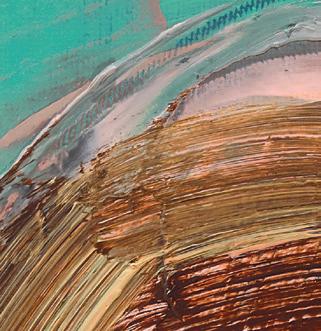



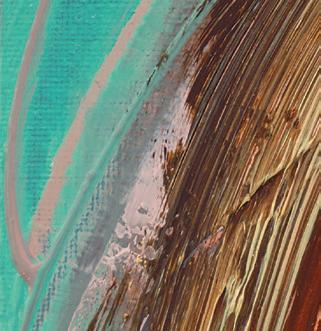


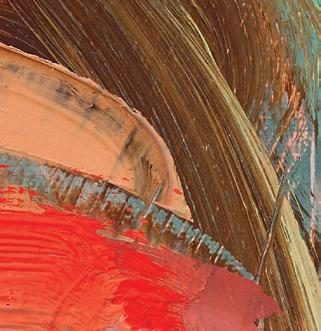
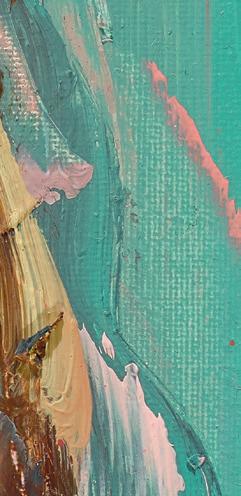



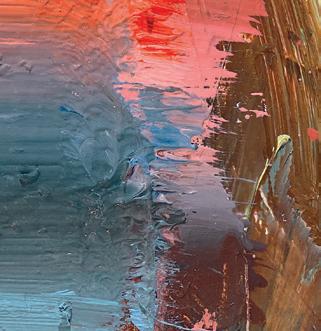

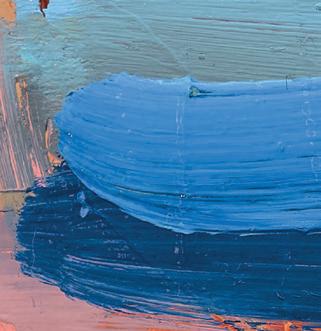
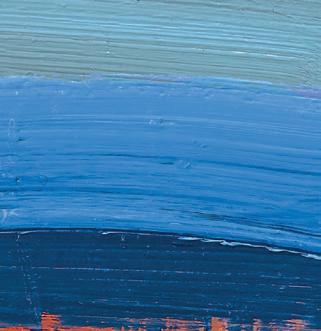


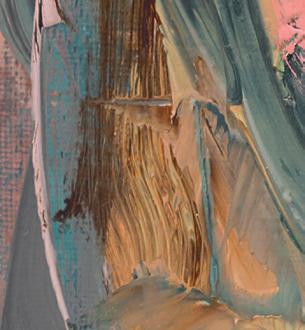





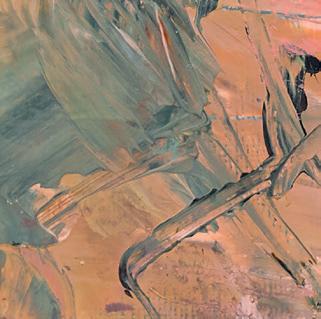




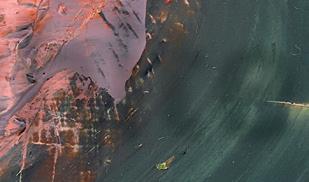


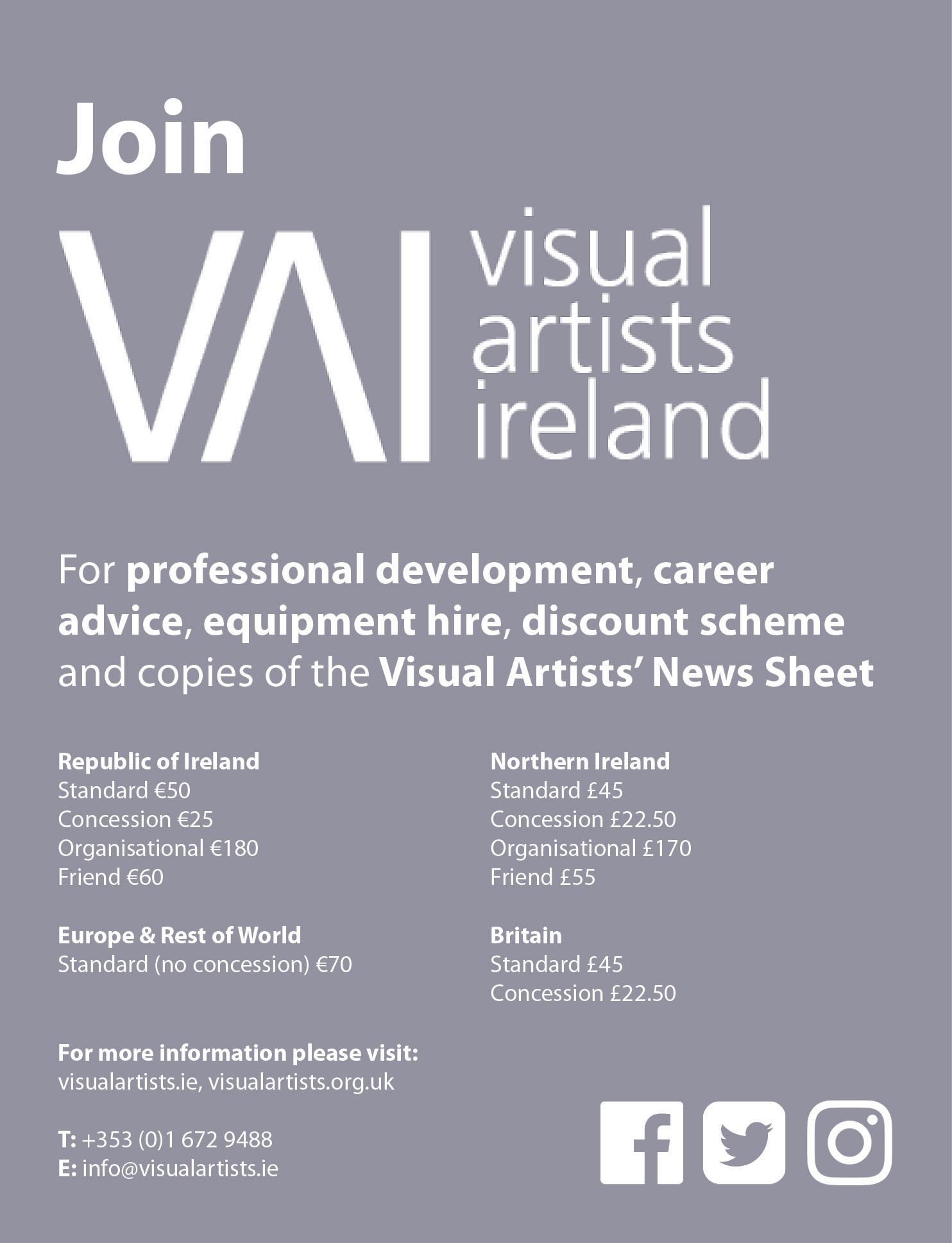
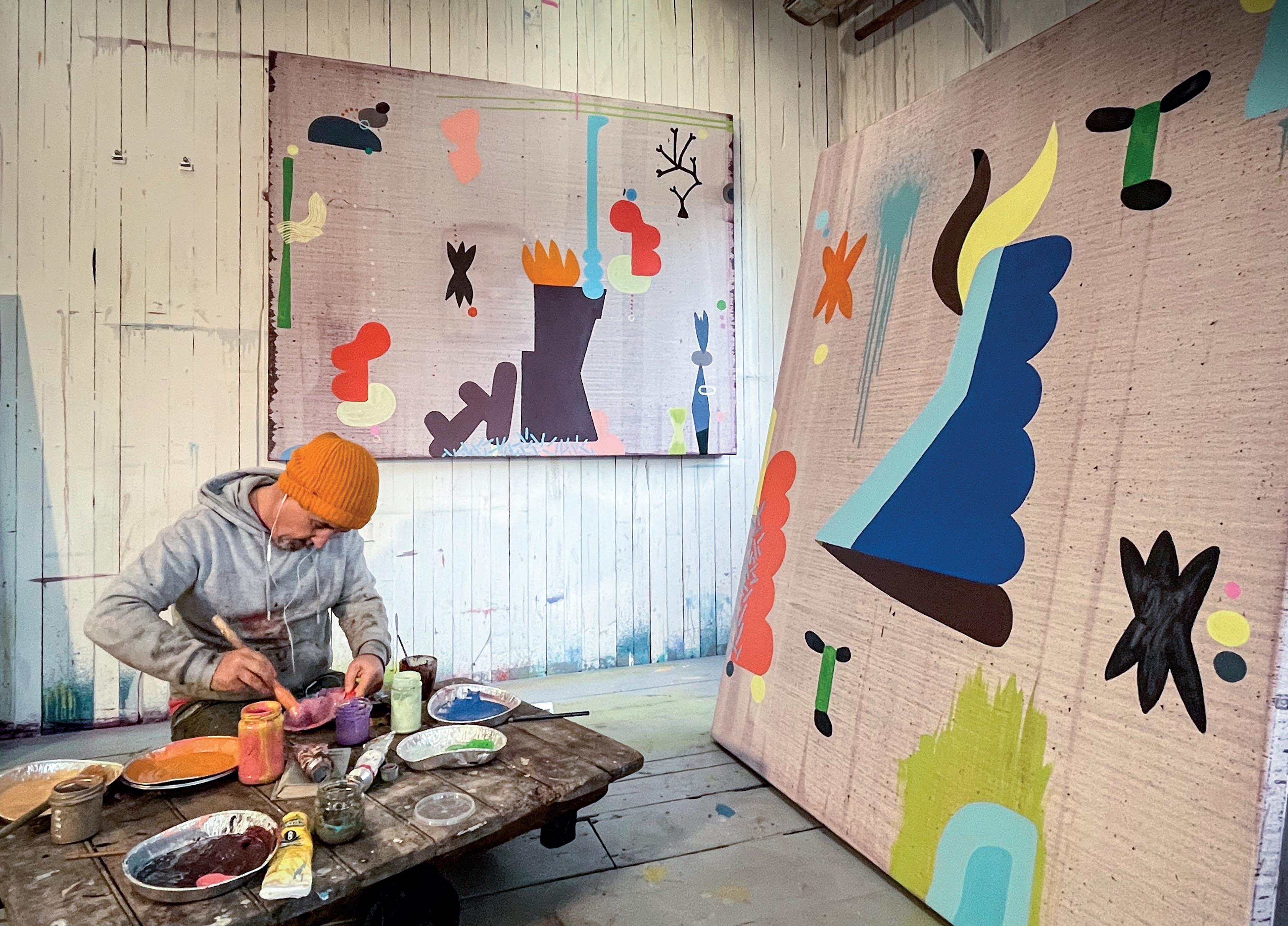
Sylvia
Linda Norris
David Begley
17/04
Opening: Friday 14 April at 6pm
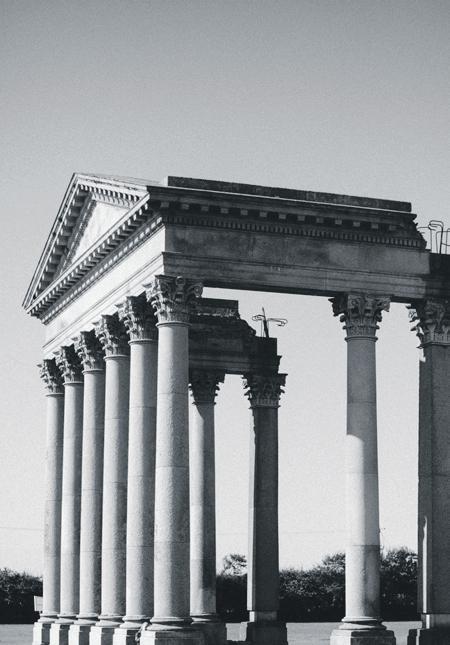

Opening Hours: Mon - Fri 9am-5pm
www.wexfordcoco.ie / +353 (0)53 9196369


Fingal County Council, in association with the Tyrone Guthrie Centre and the Bealtaine Festival are offering two, one-month long residencies at the Tyrone Guthrie Centre. The award aims to celebrate and support older artists at all stages of their careers working in visual arts and literature.
The residencies will offer a professional visual artist and a professional writer, working in any discipline, the opportunity to research or develop new work, with the potential, if desired, to present work during Bealtaine 2024.
Closing date for receipt of applications: Monday 27th March 2023 at 4.00pm
To be eligible to apply applicants must be aged 50+, have been born, studied, or currently reside in Fingal. Applications are welcomed and encouraged from artists from diverse cultural or minority backgrounds. The residency will take place between June and December 2023 at a date to be agreed with the successful candidates.
For further information and to apply please visit: www.fingalarts.ie/news or www.fingal.ie/arts

 Seán Vicar y John Sunderland
Cullen
Image: David Begley, Aed's Vision, 2023, alder cone and watercolour on Fabriano, 20 x 25cm.
Seán Vicar y John Sunderland
Cullen
Image: David Begley, Aed's Vision, 2023, alder cone and watercolour on Fabriano, 20 x 25cm.